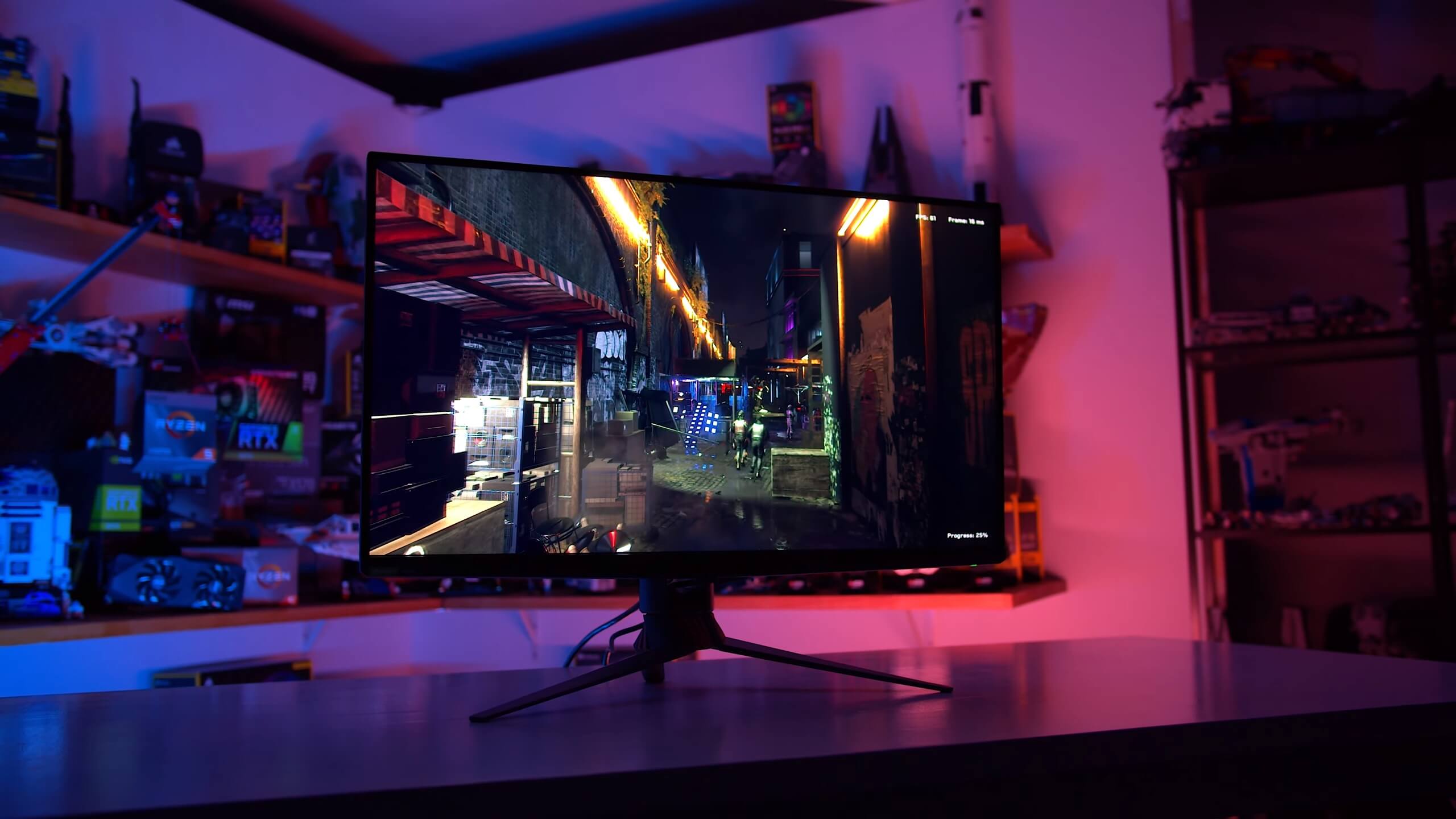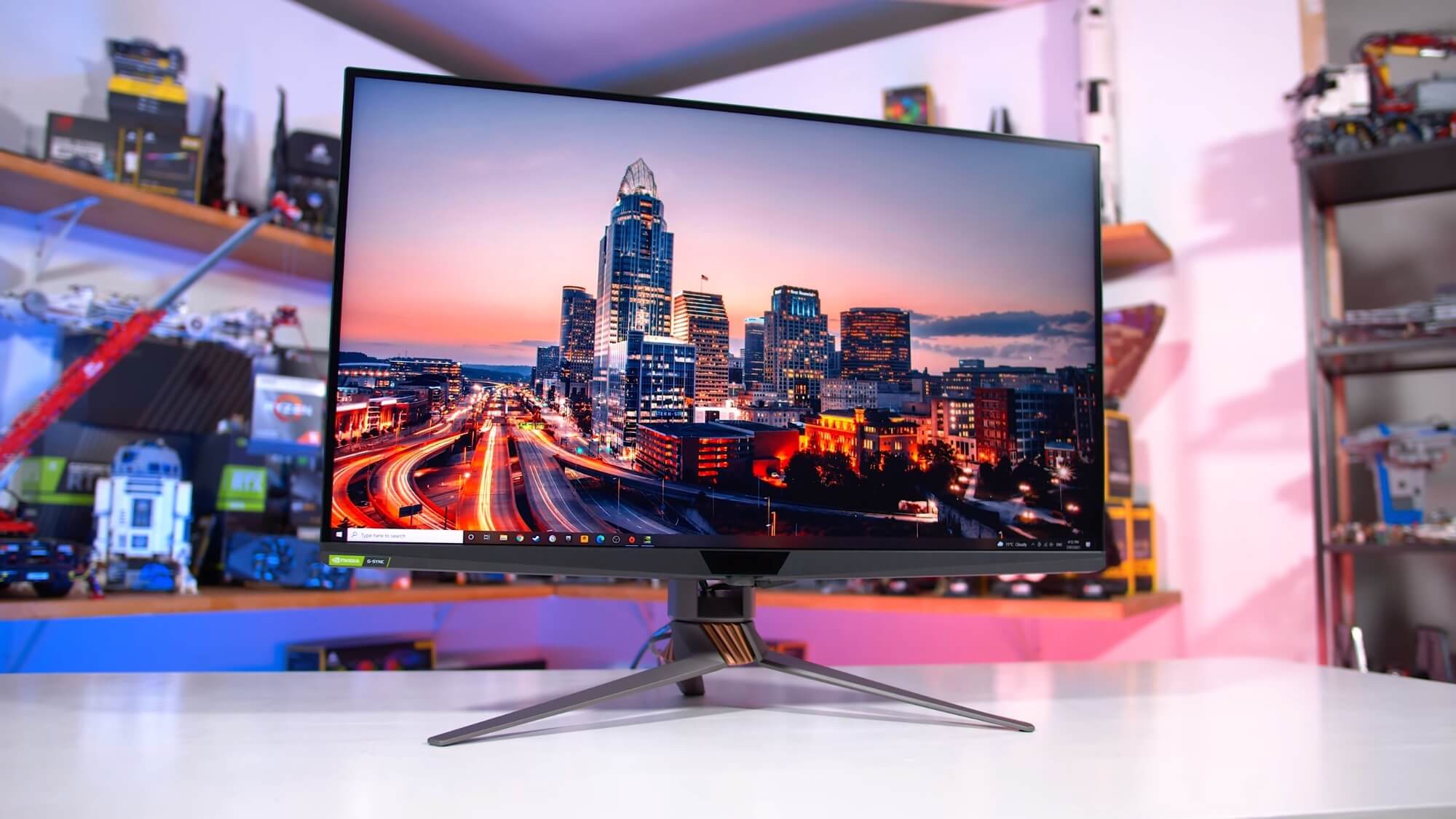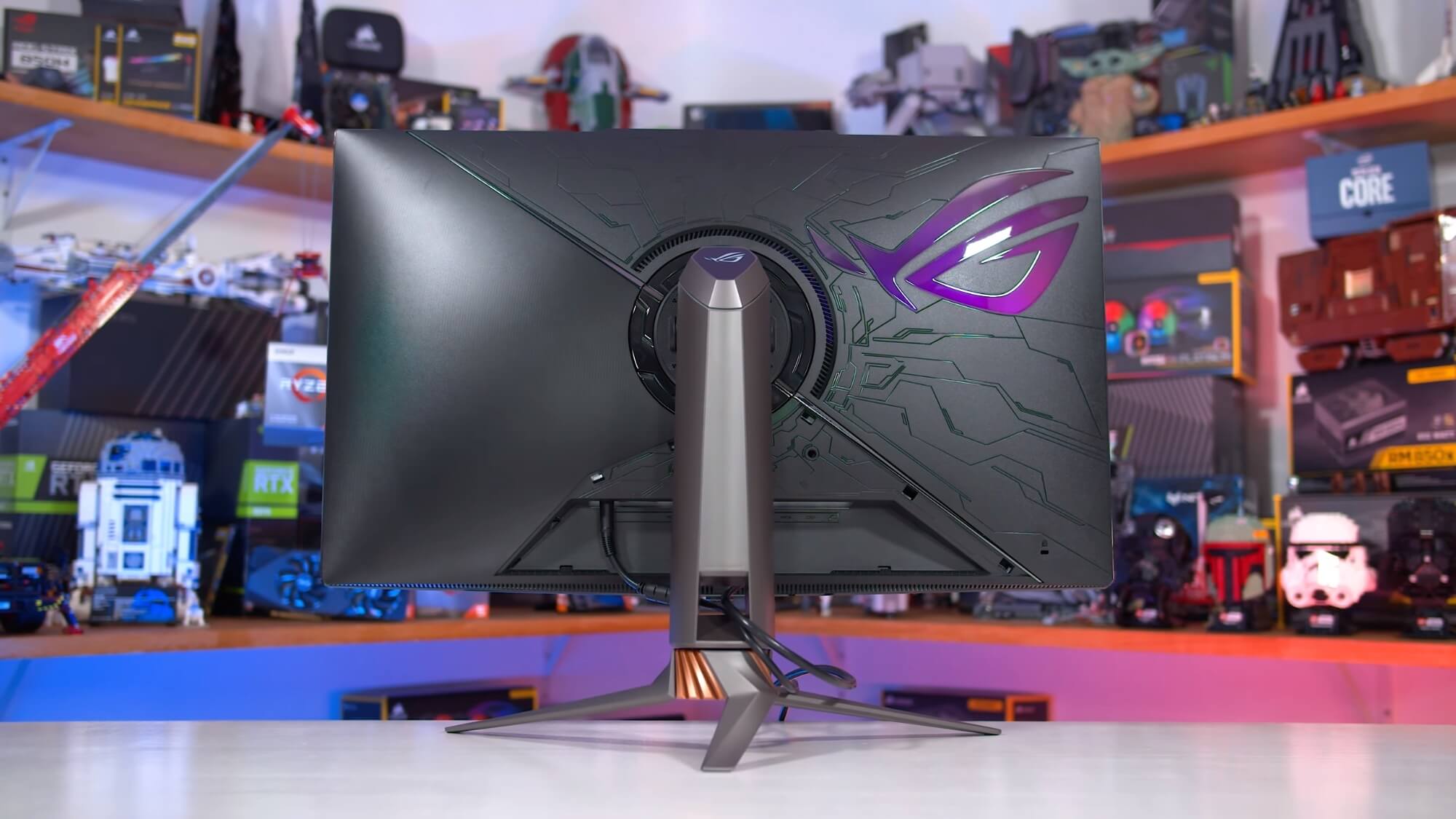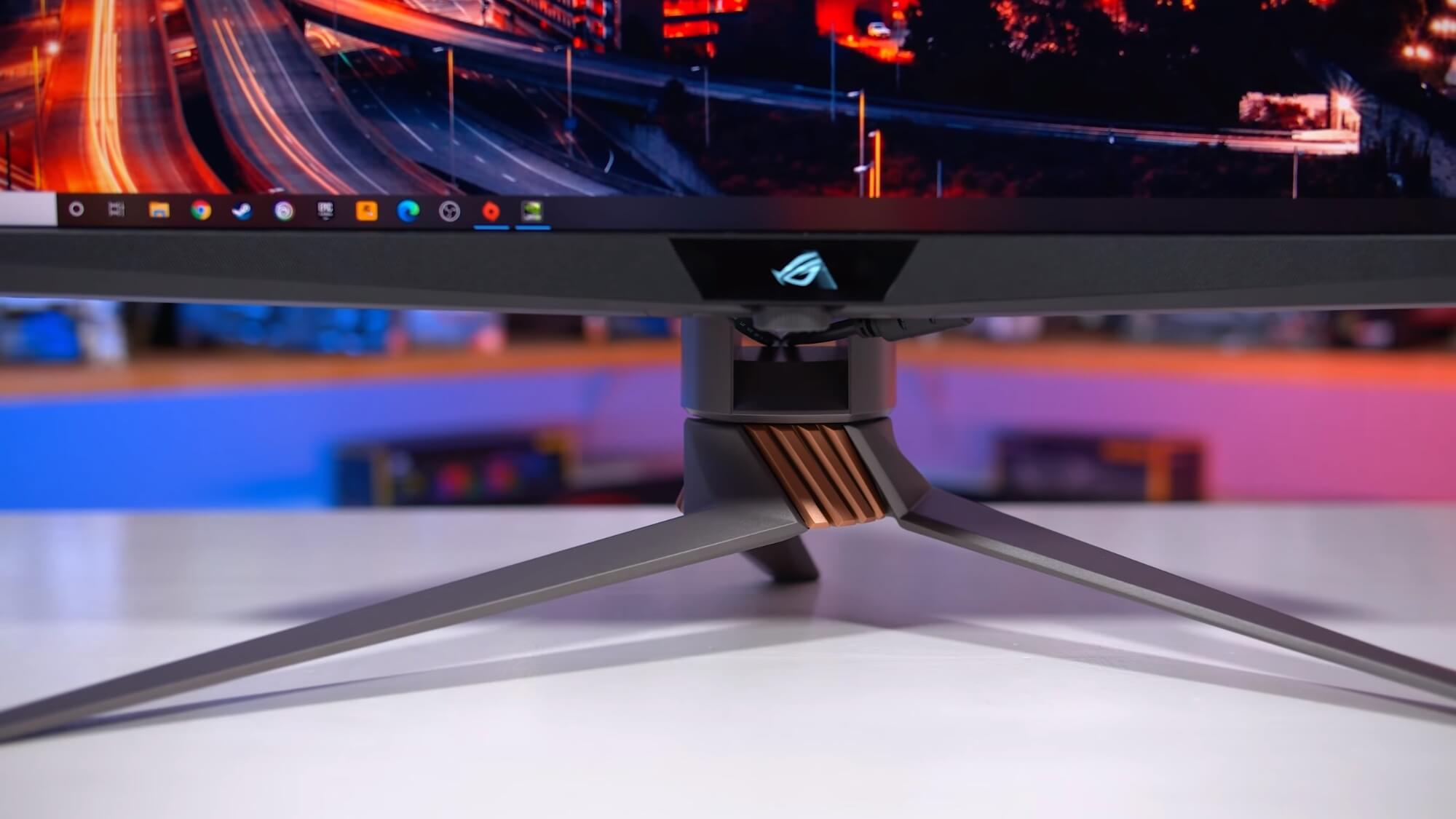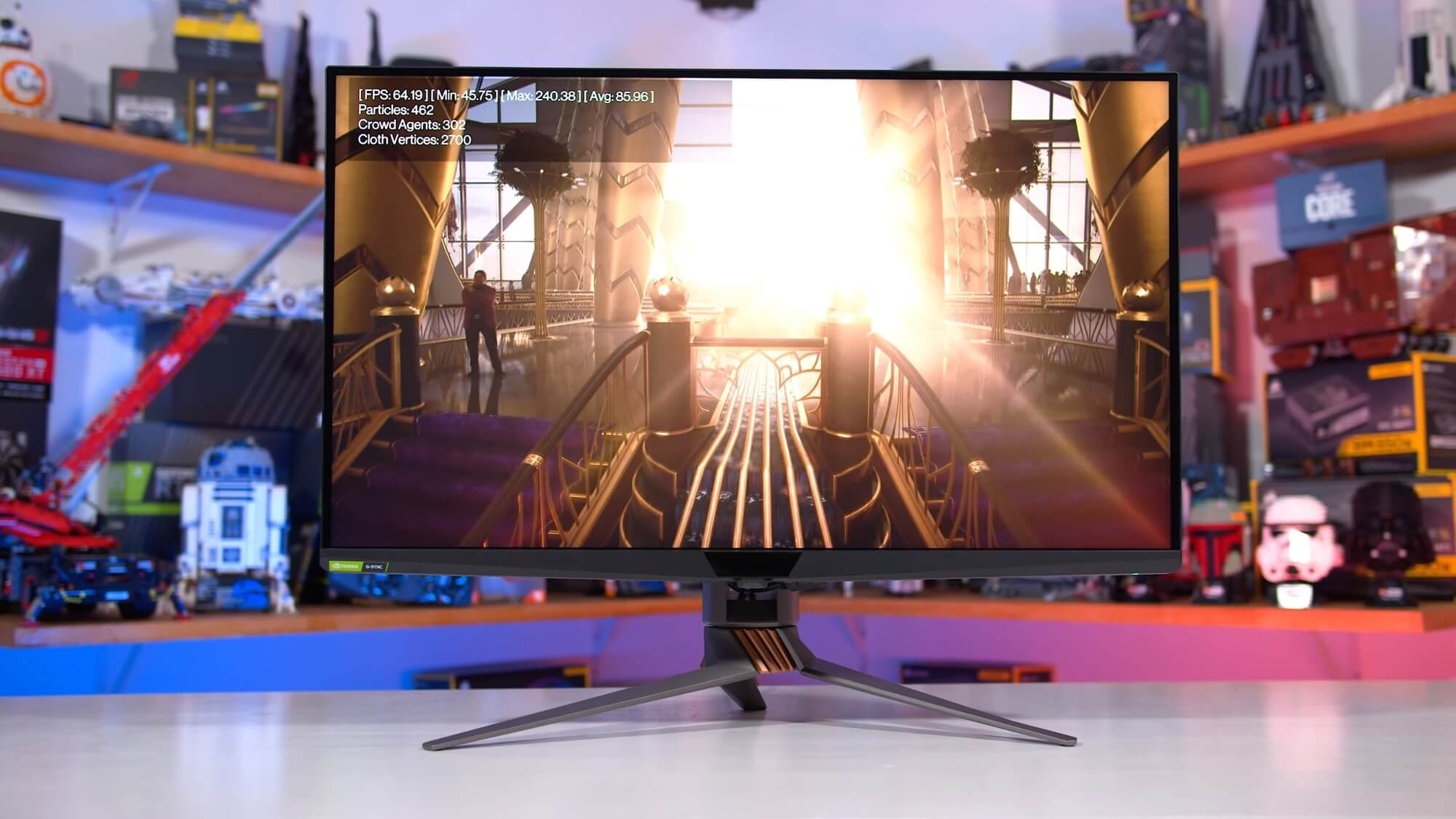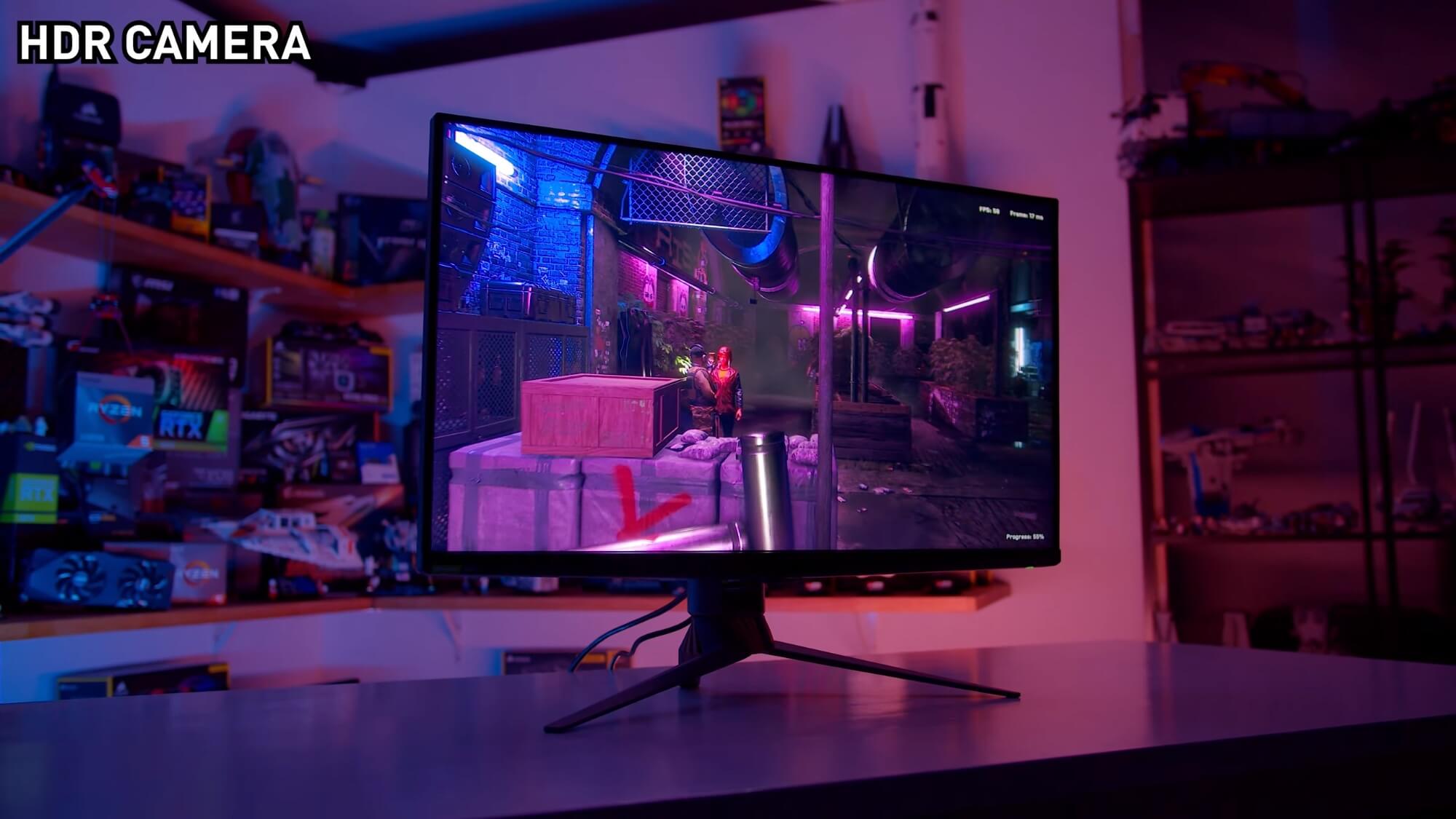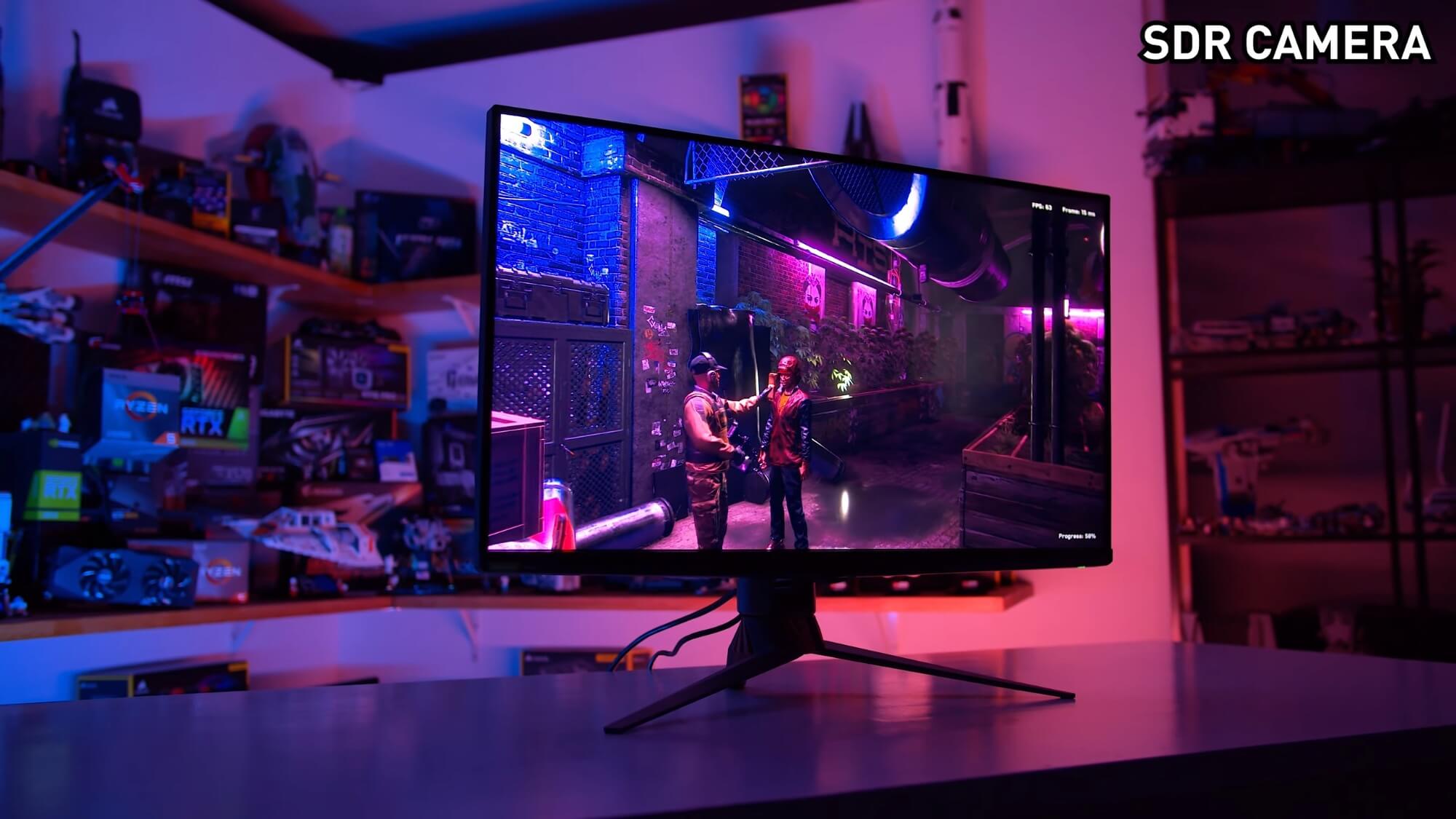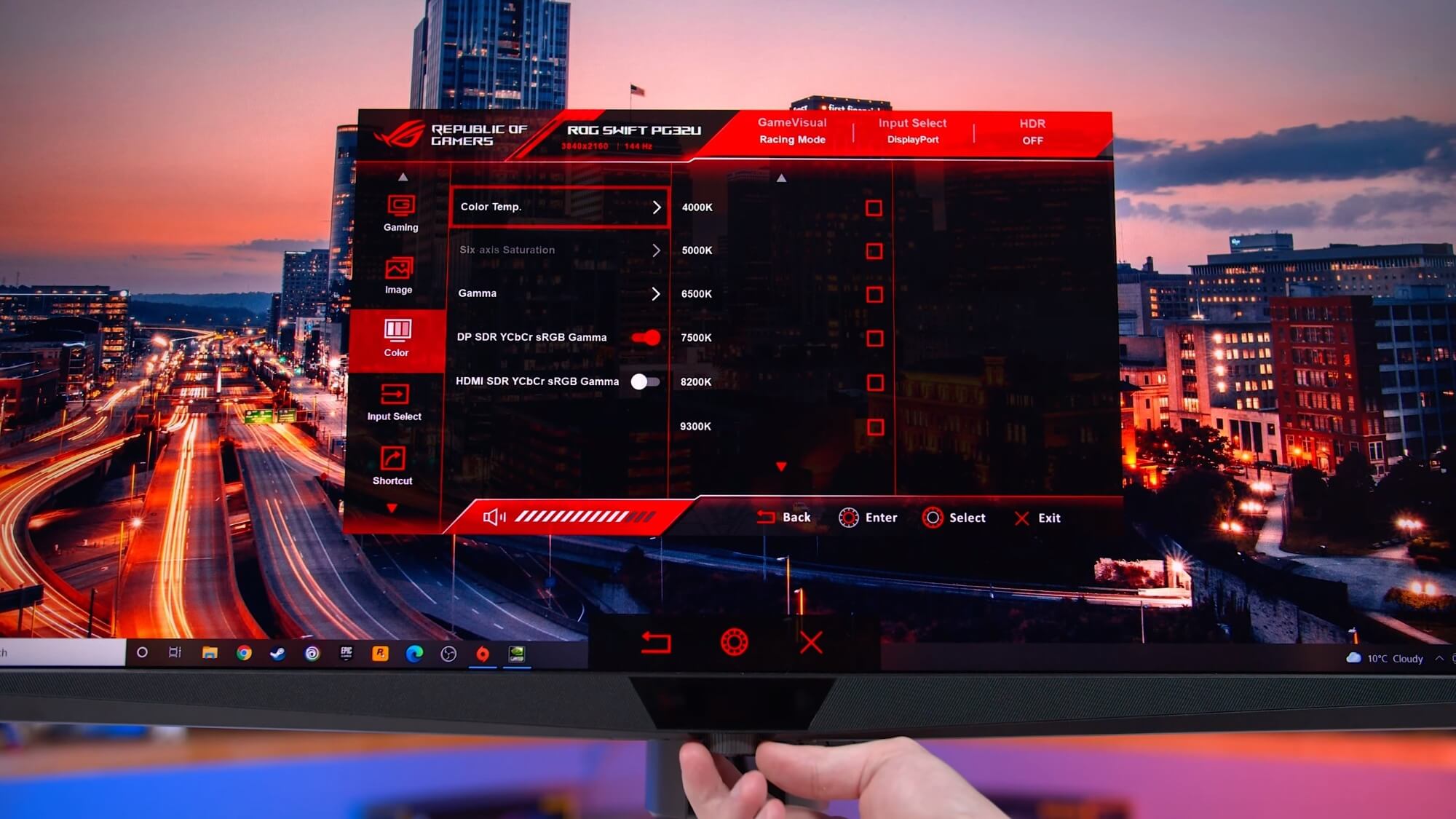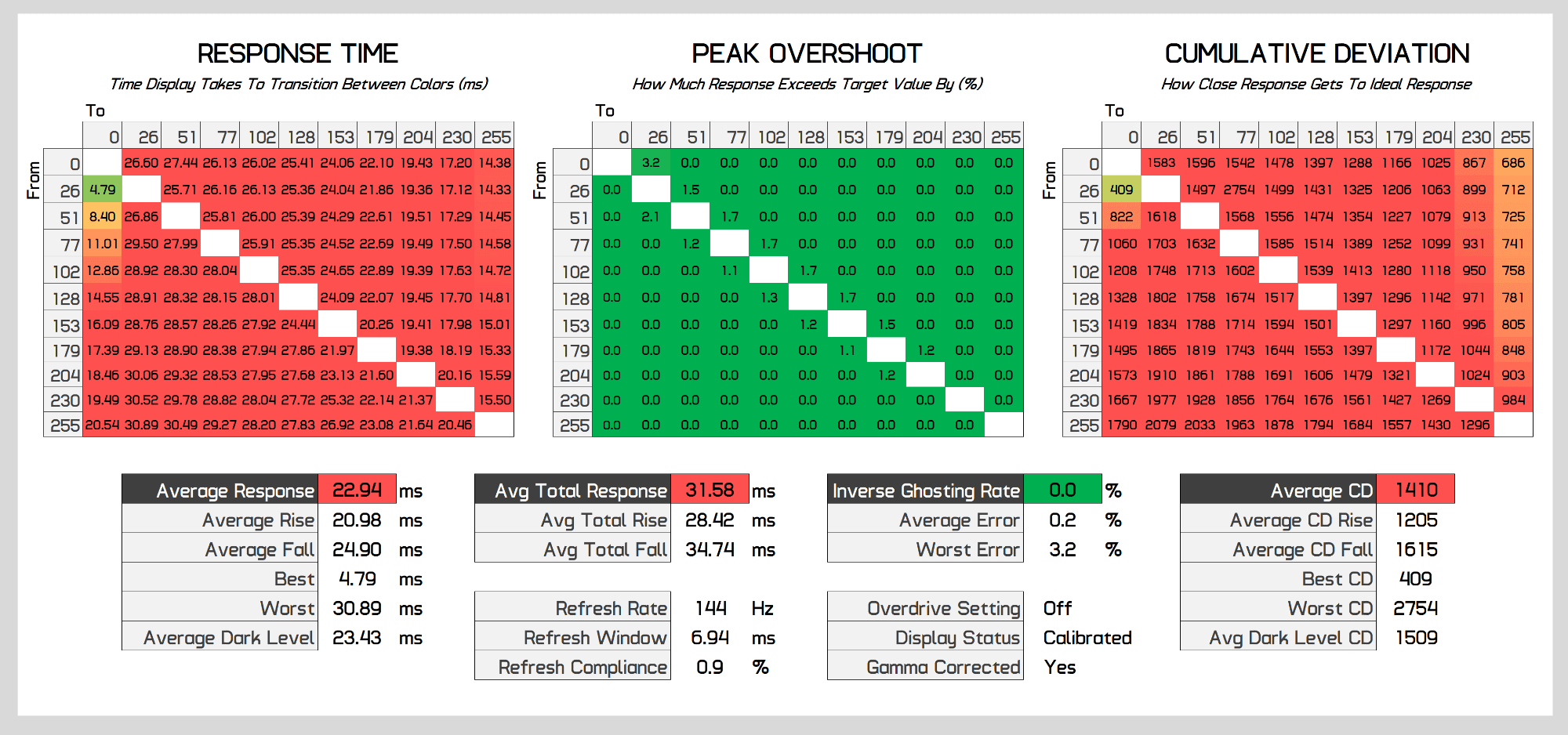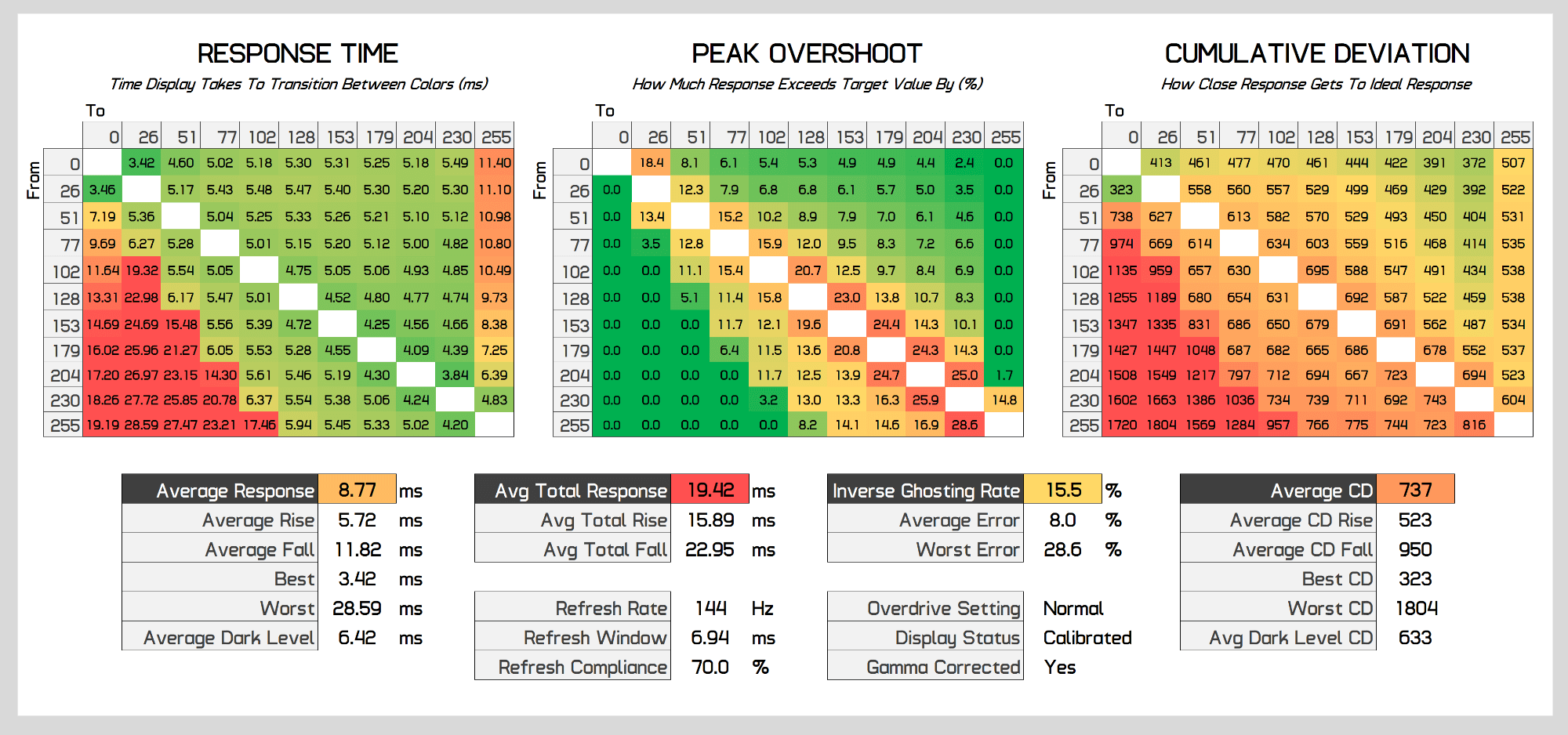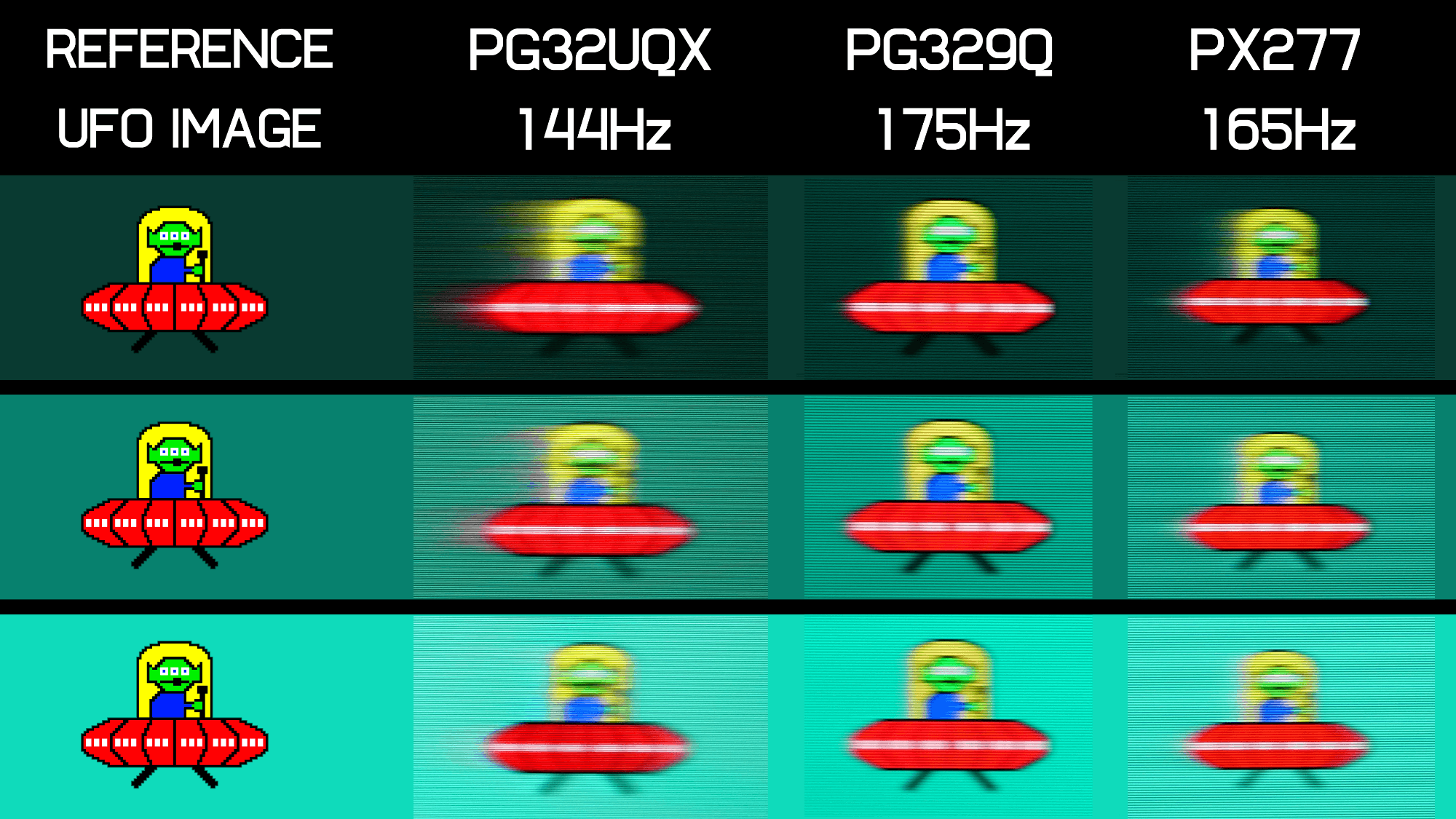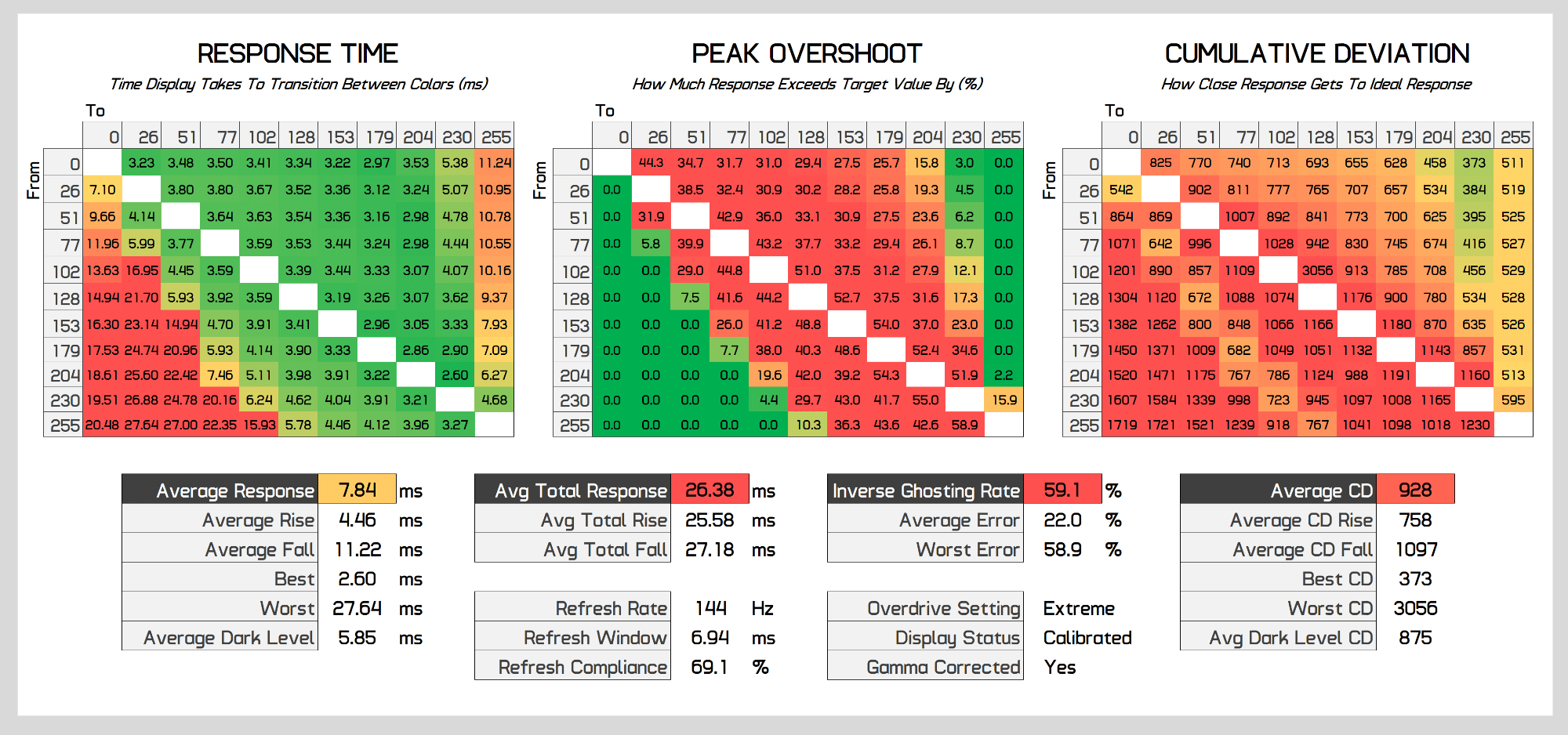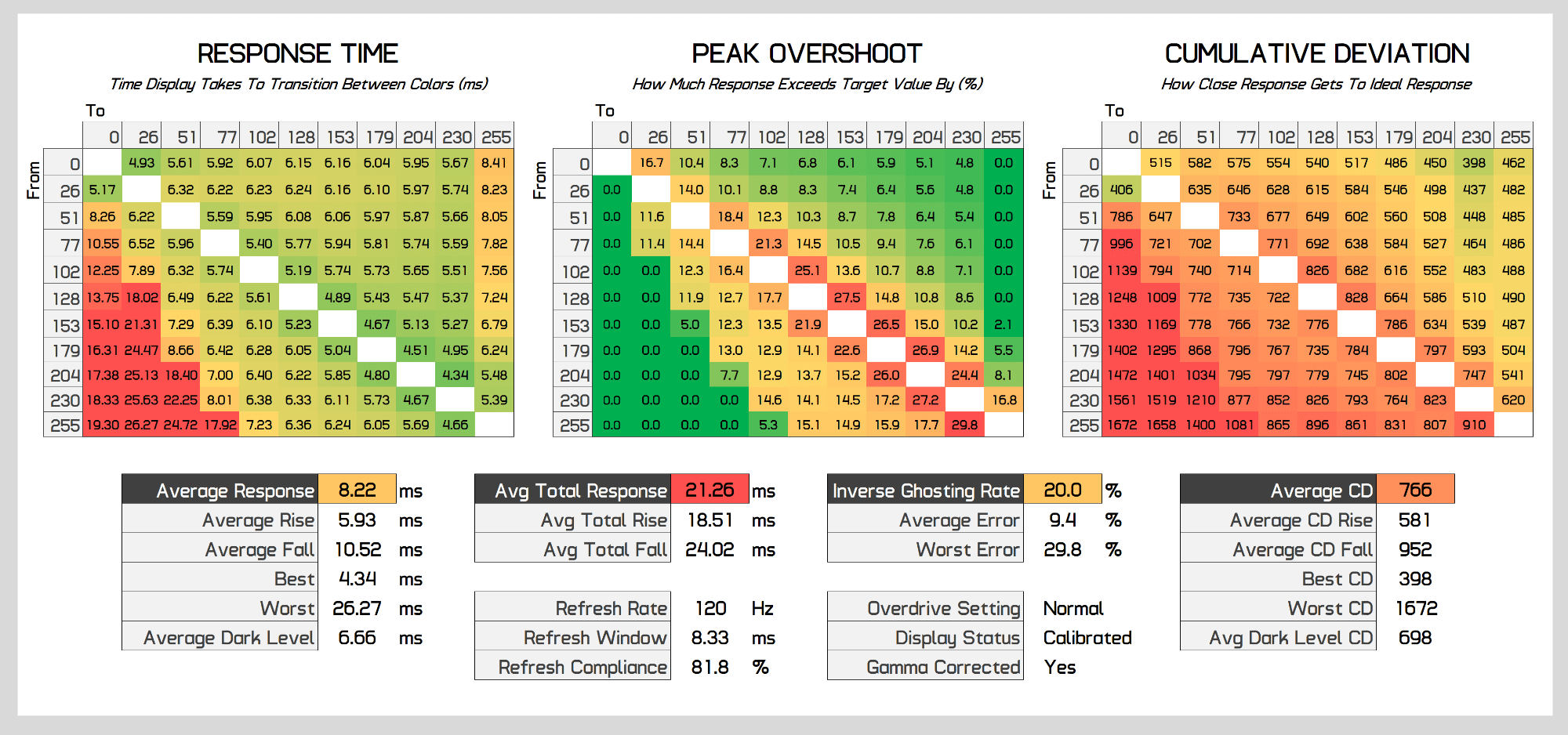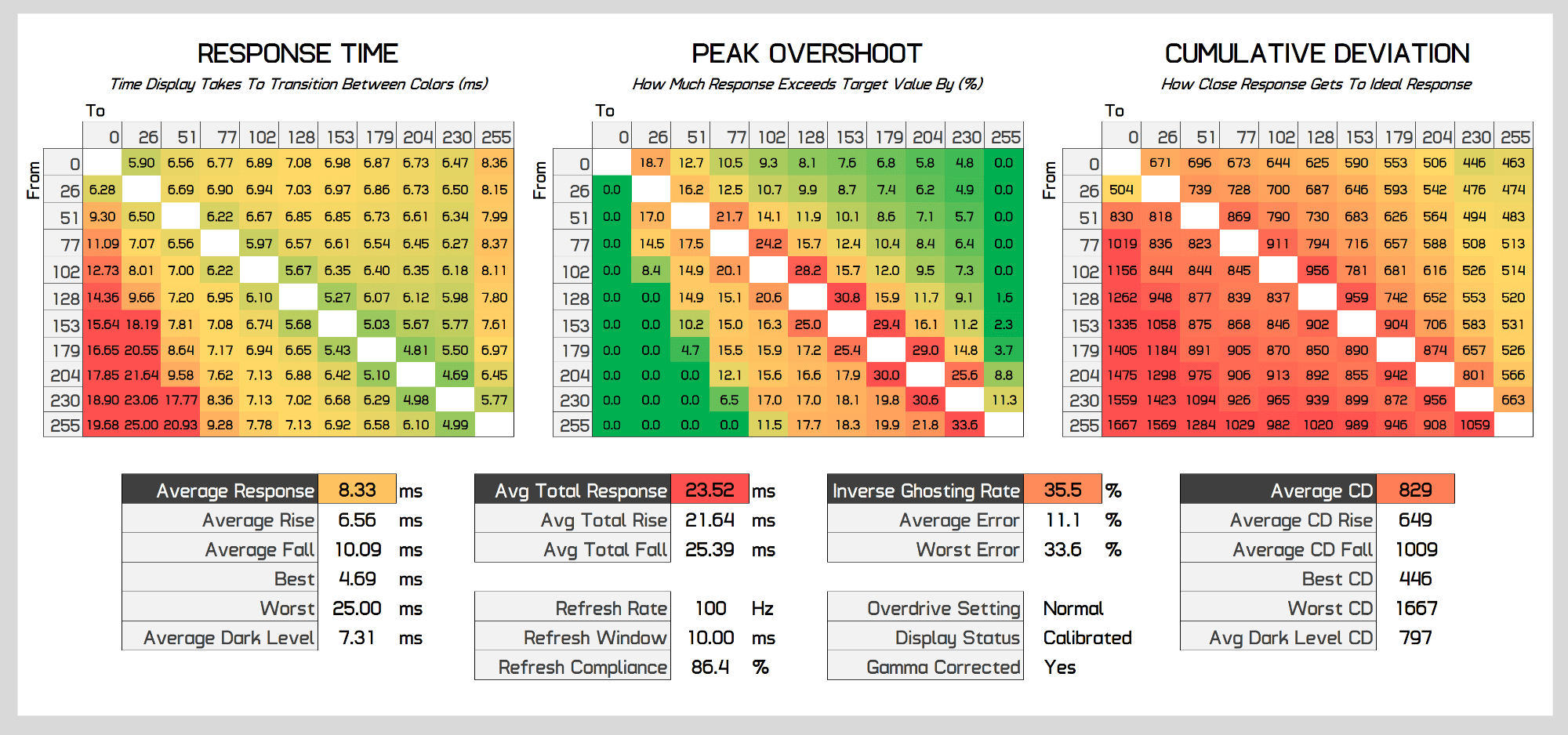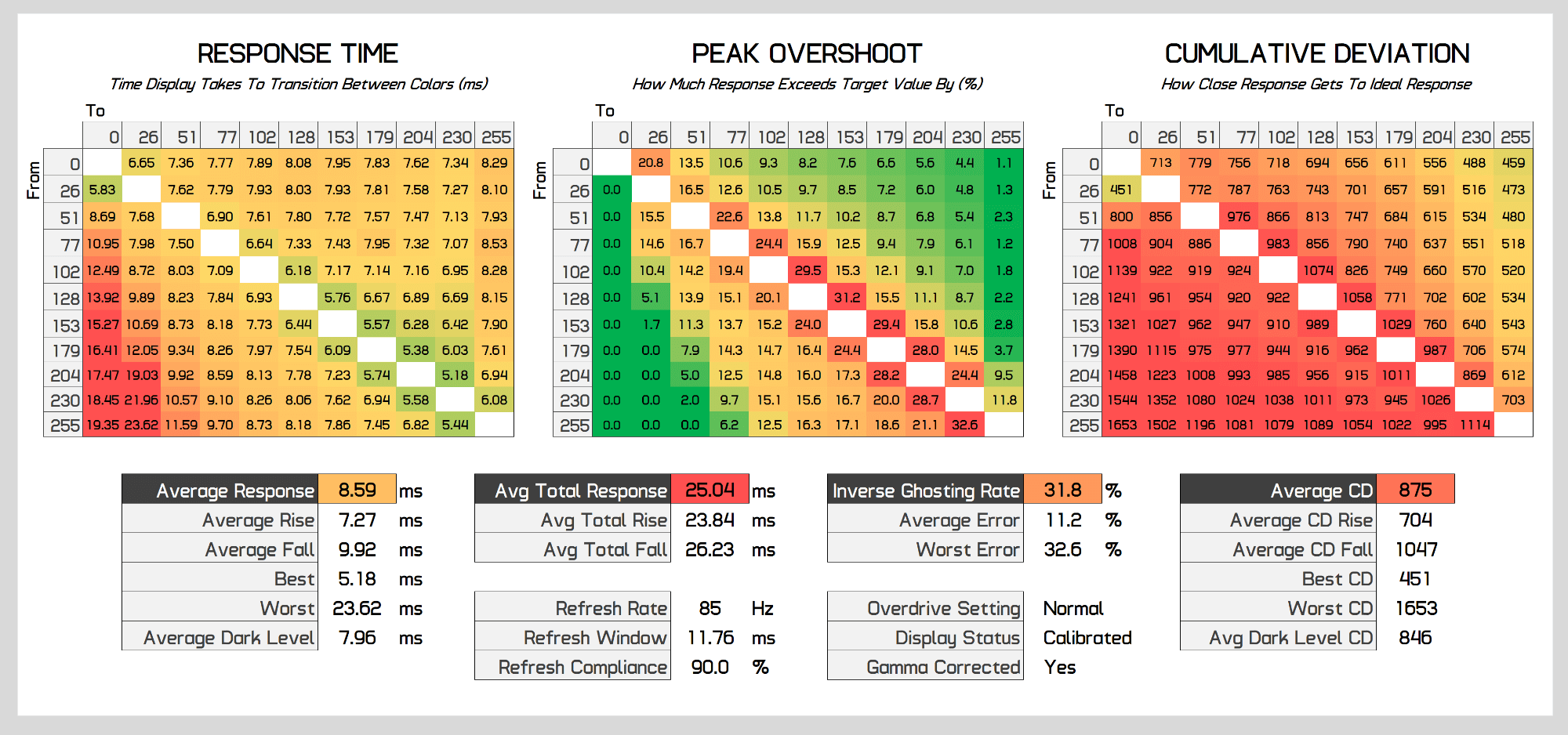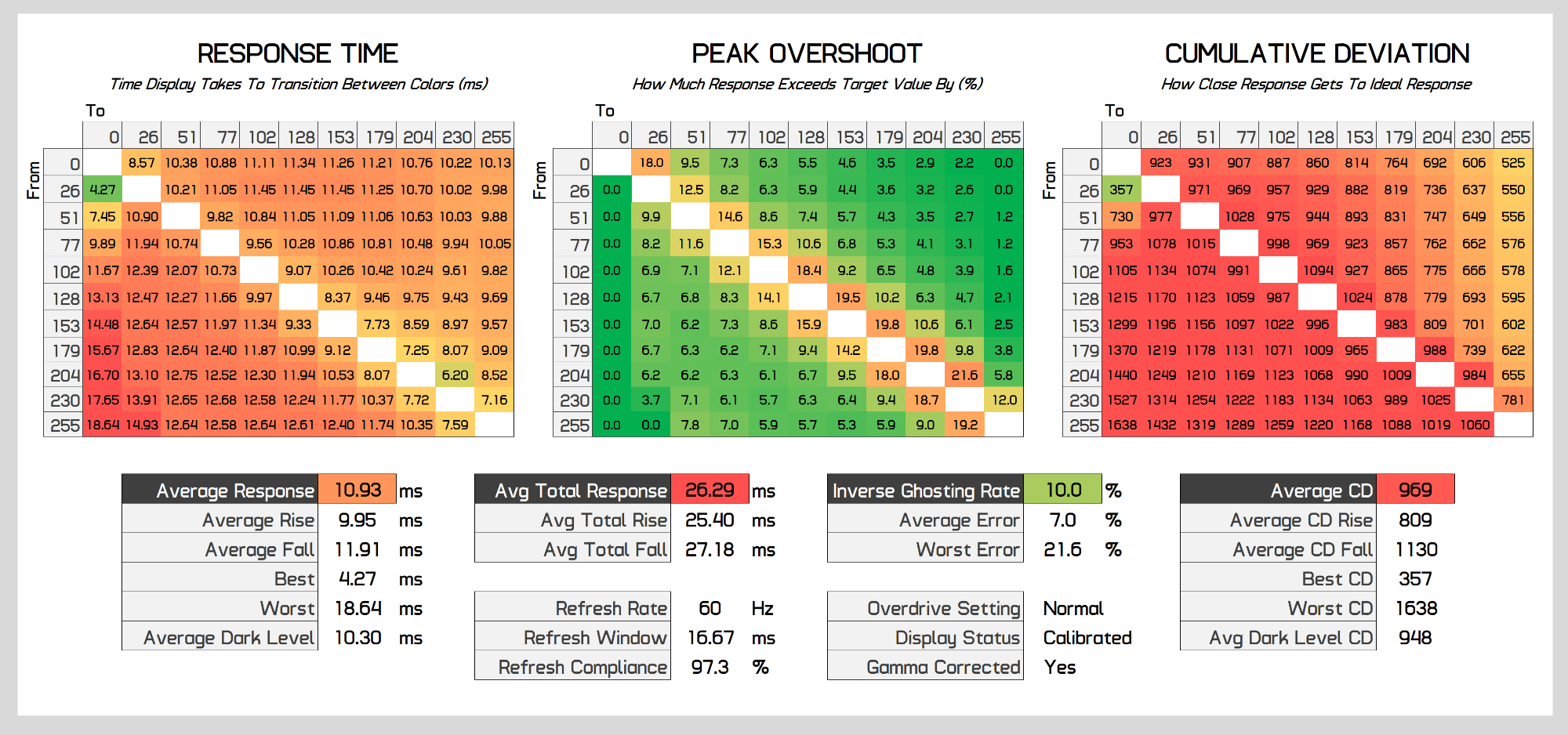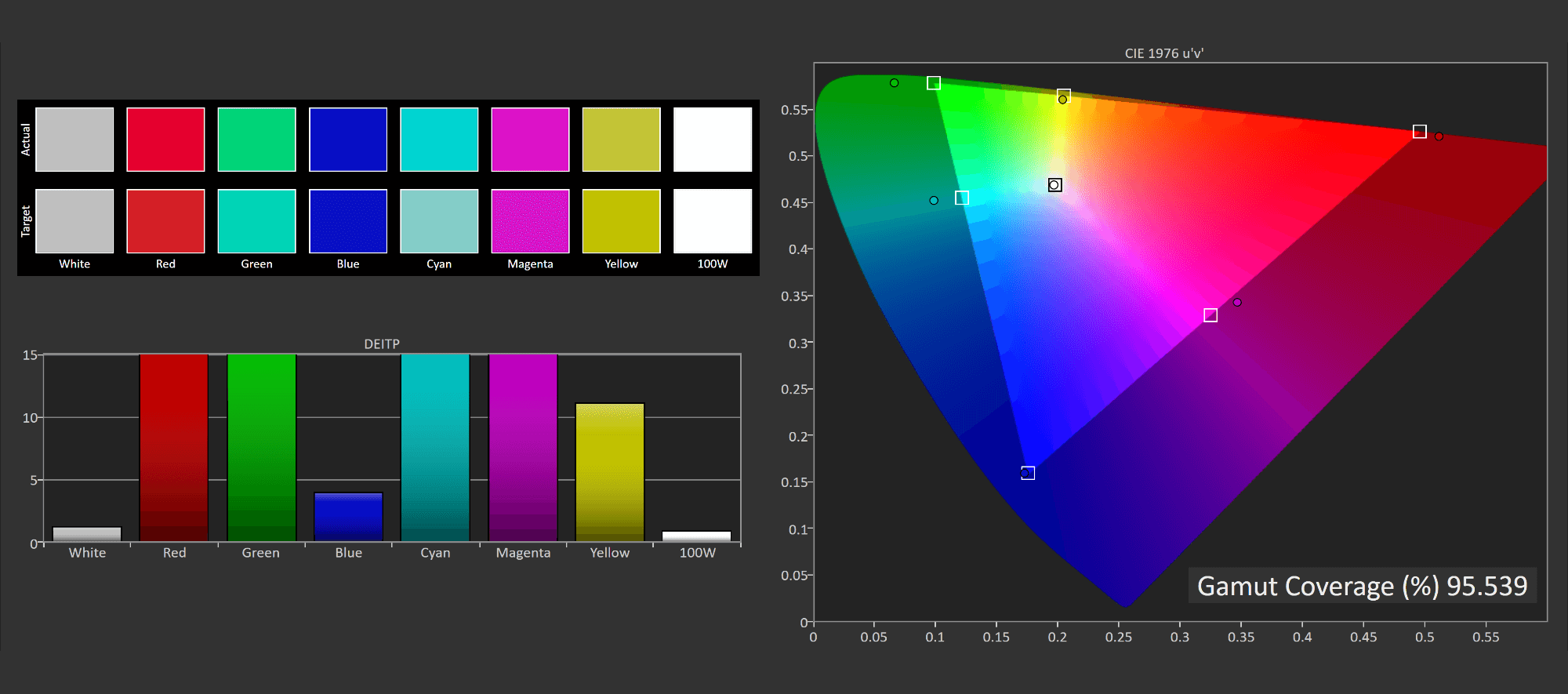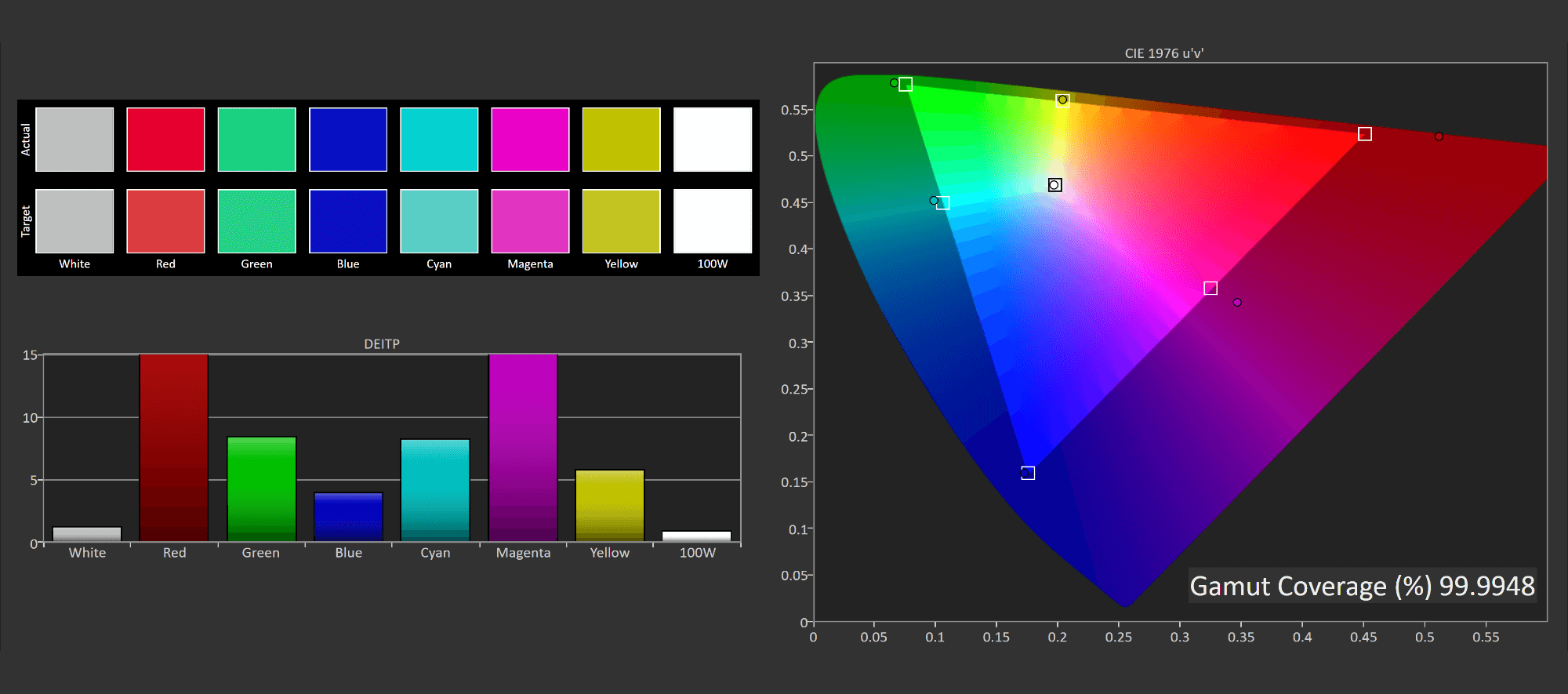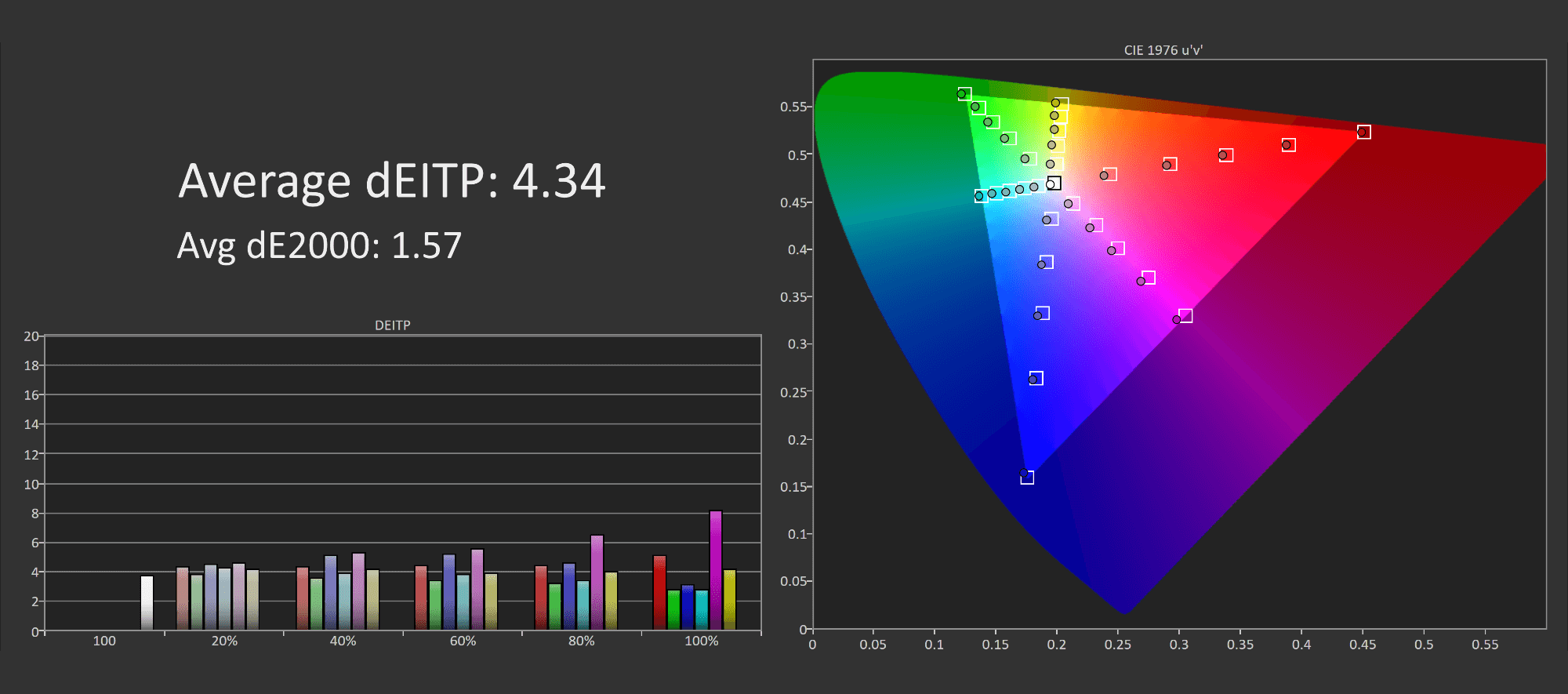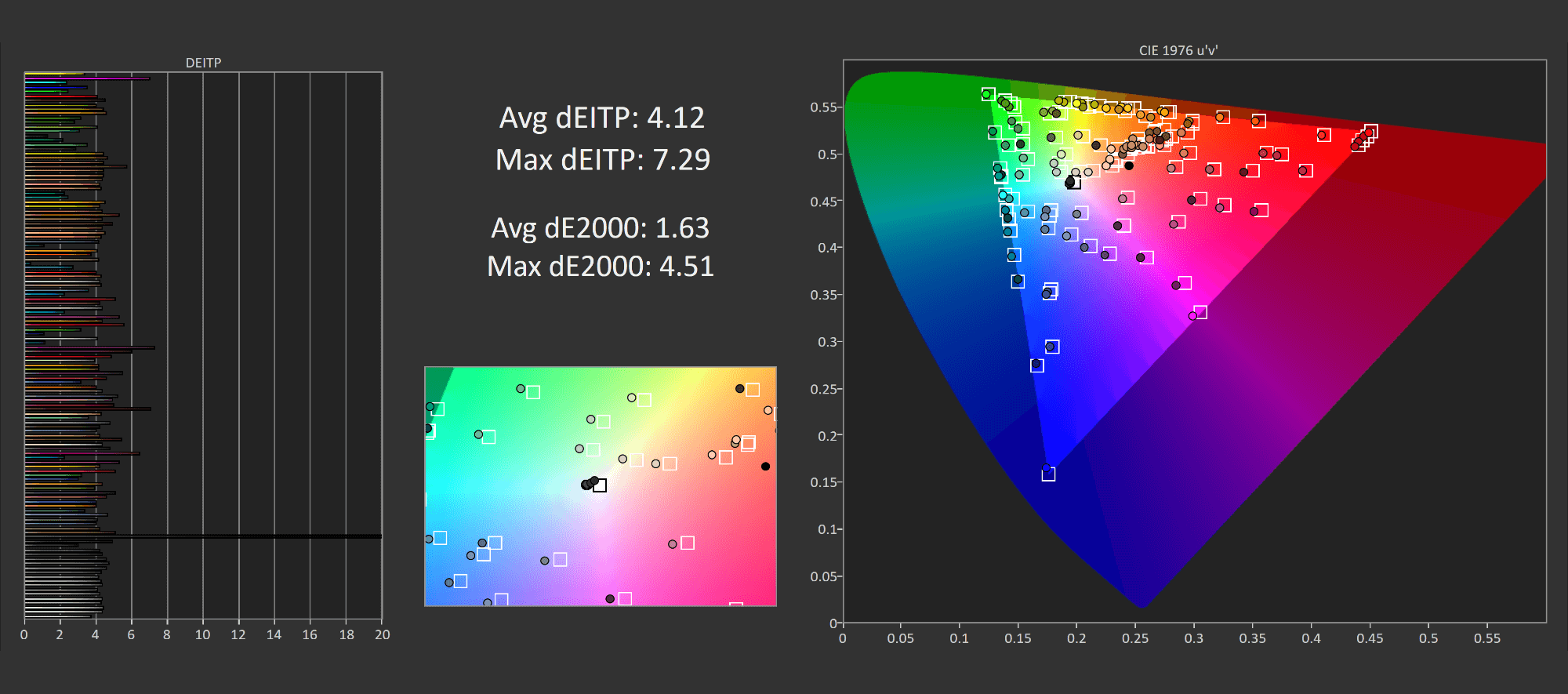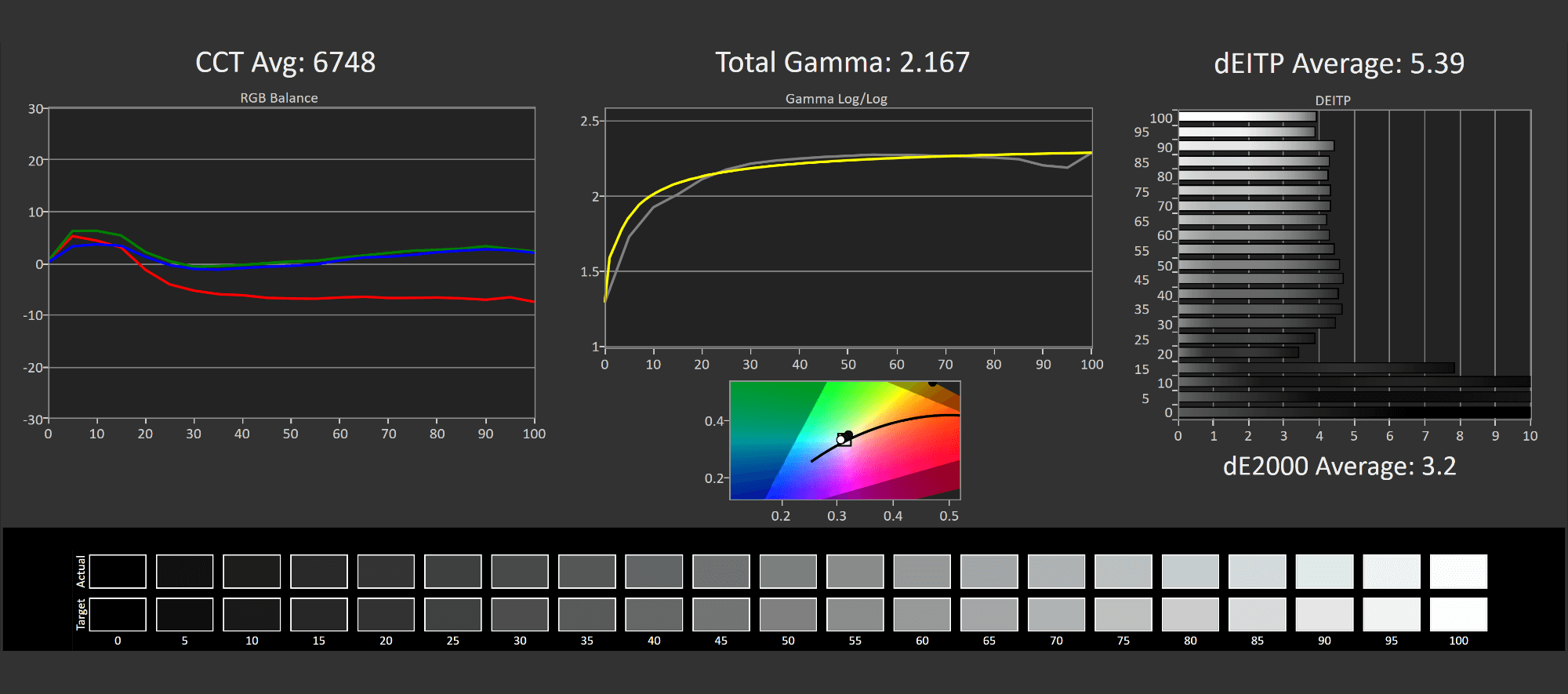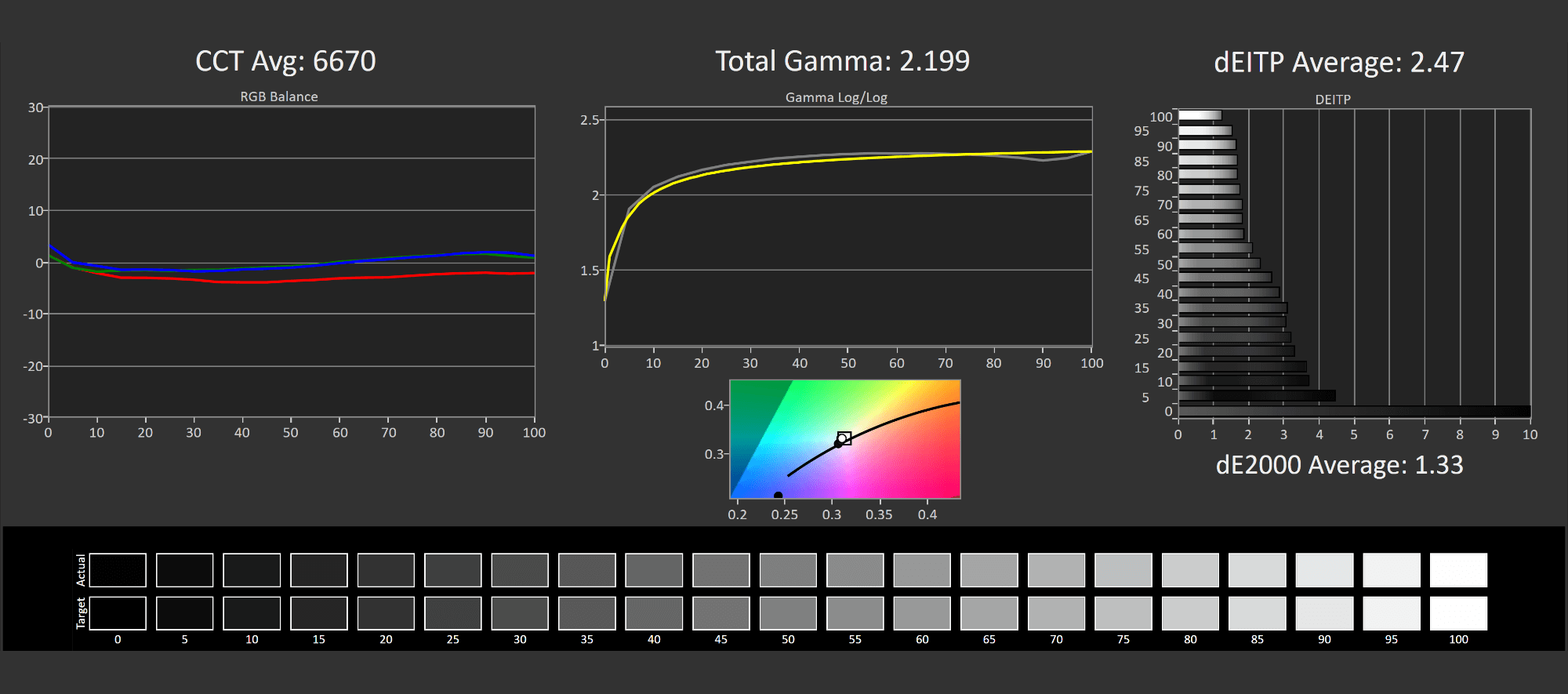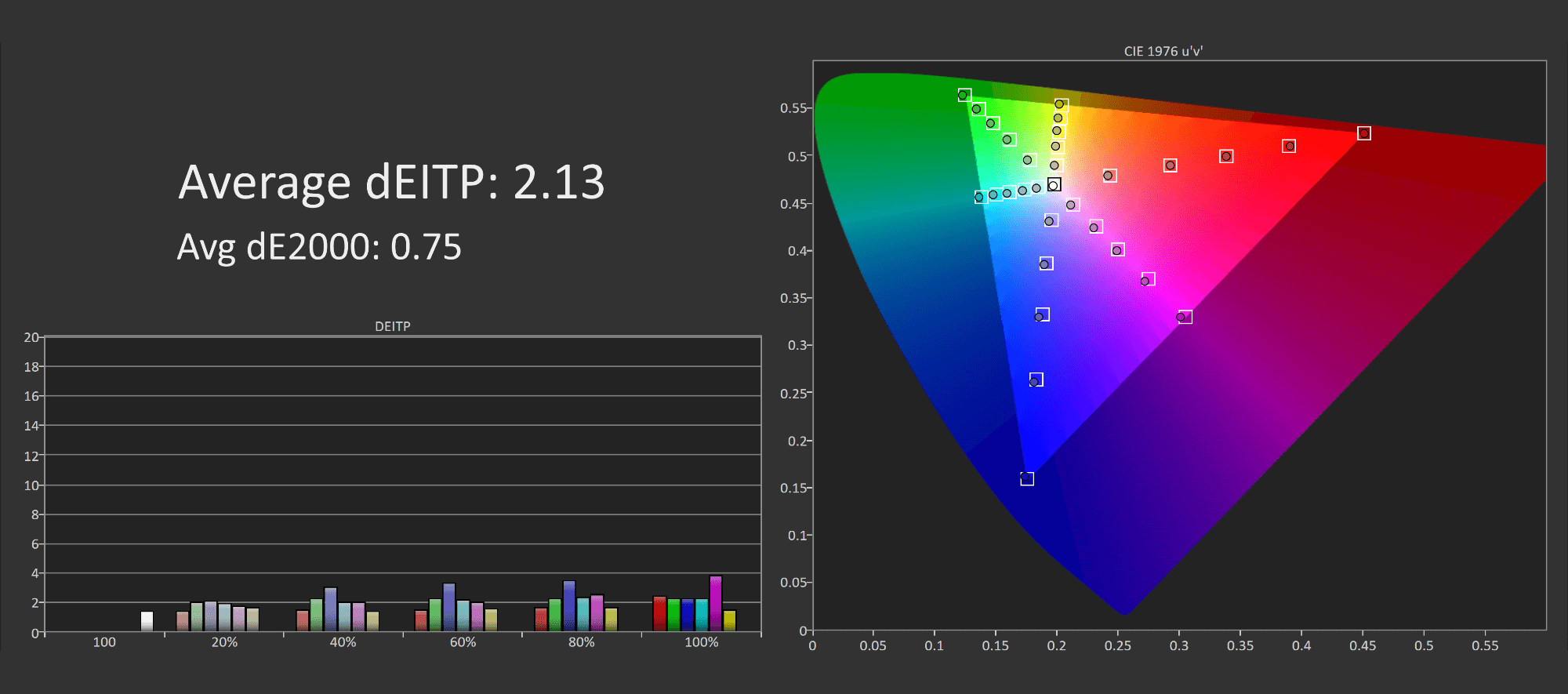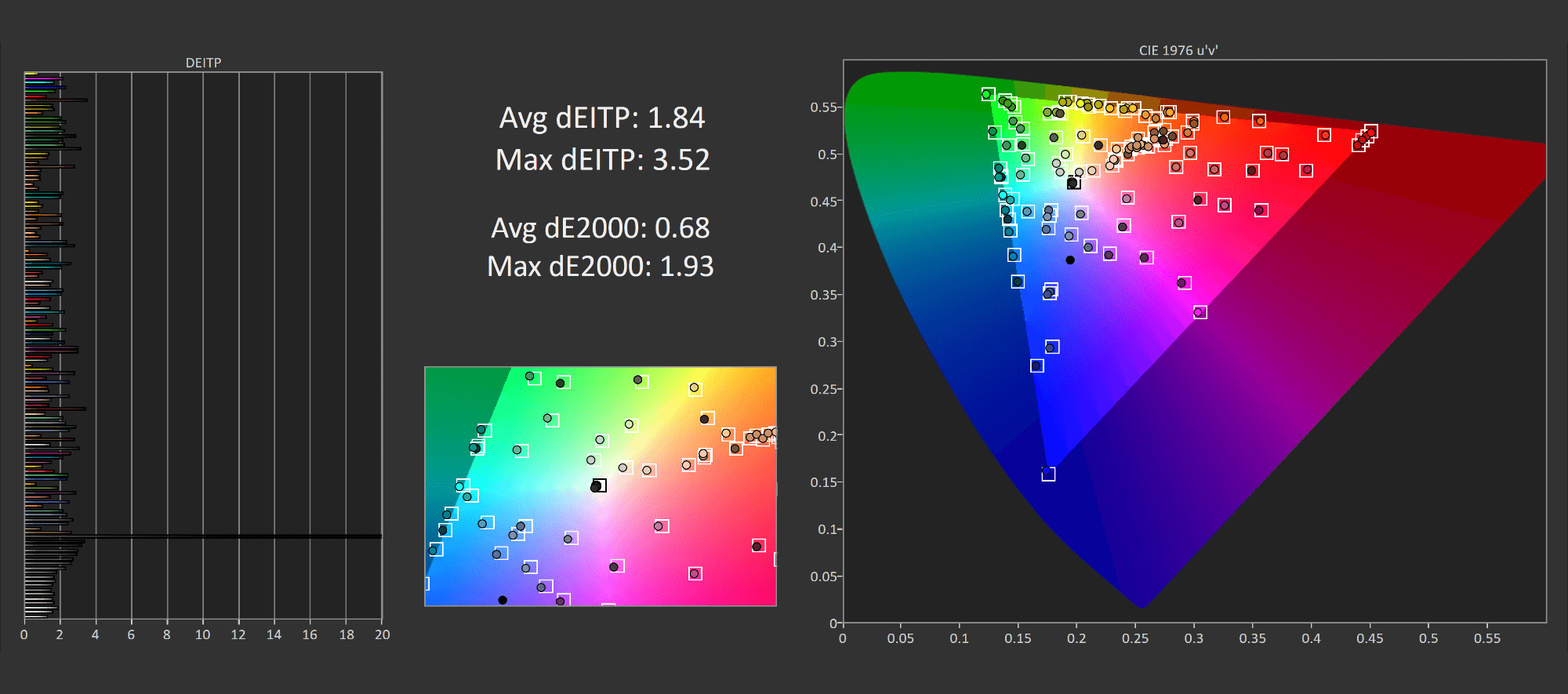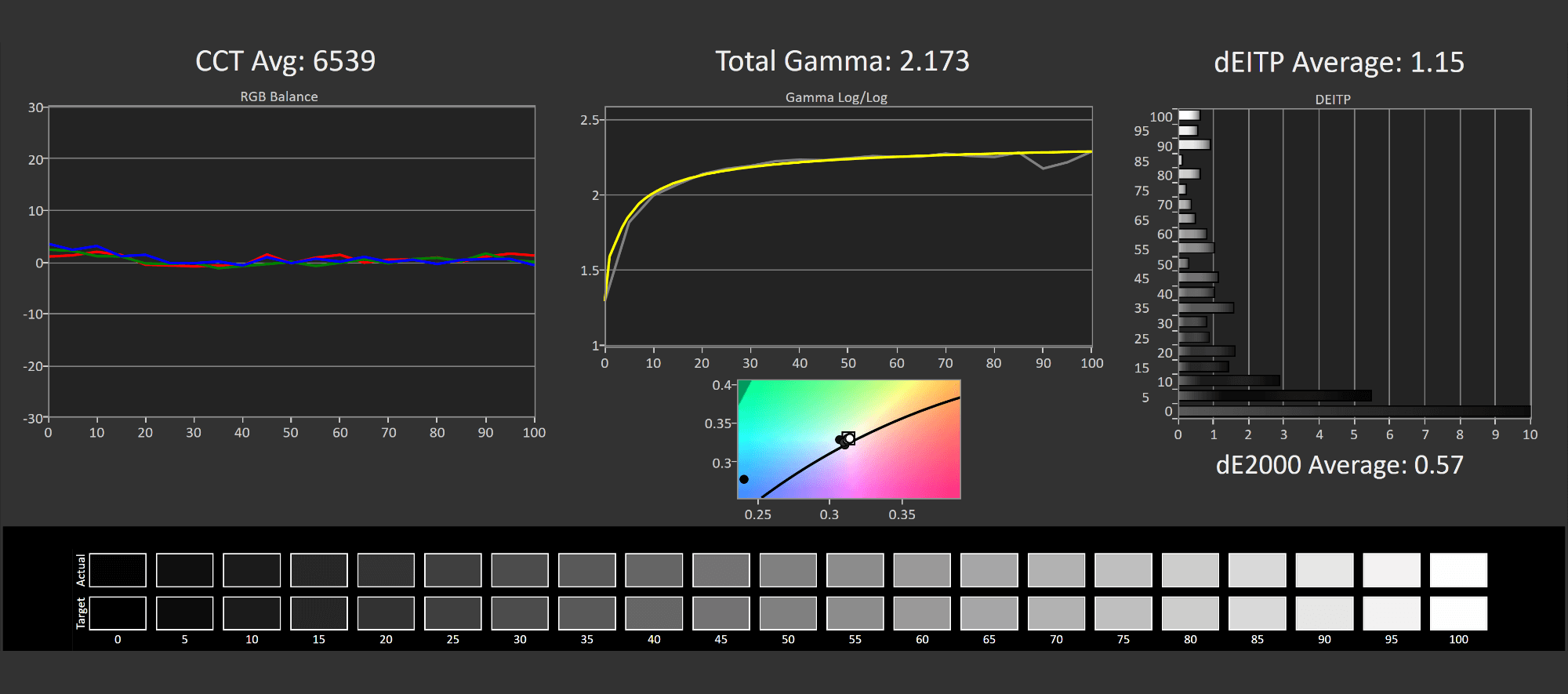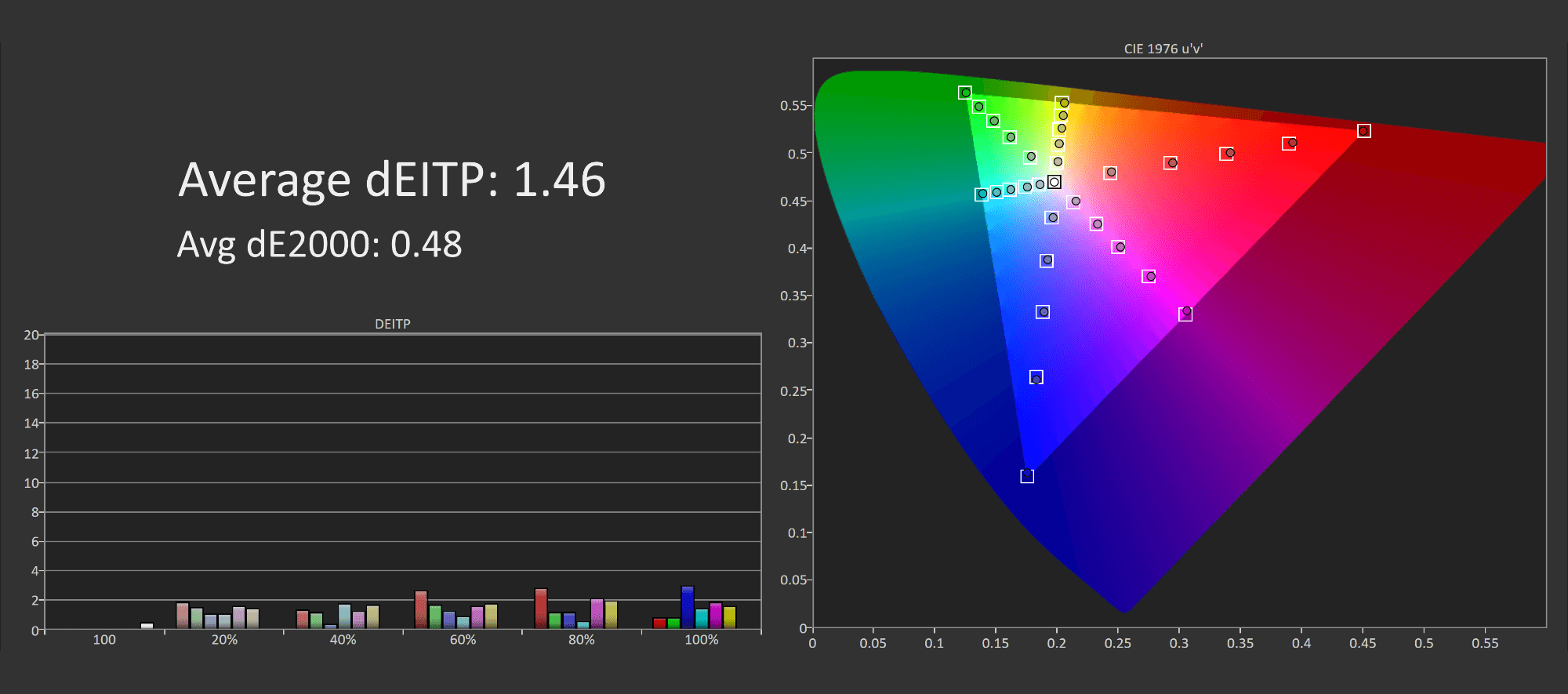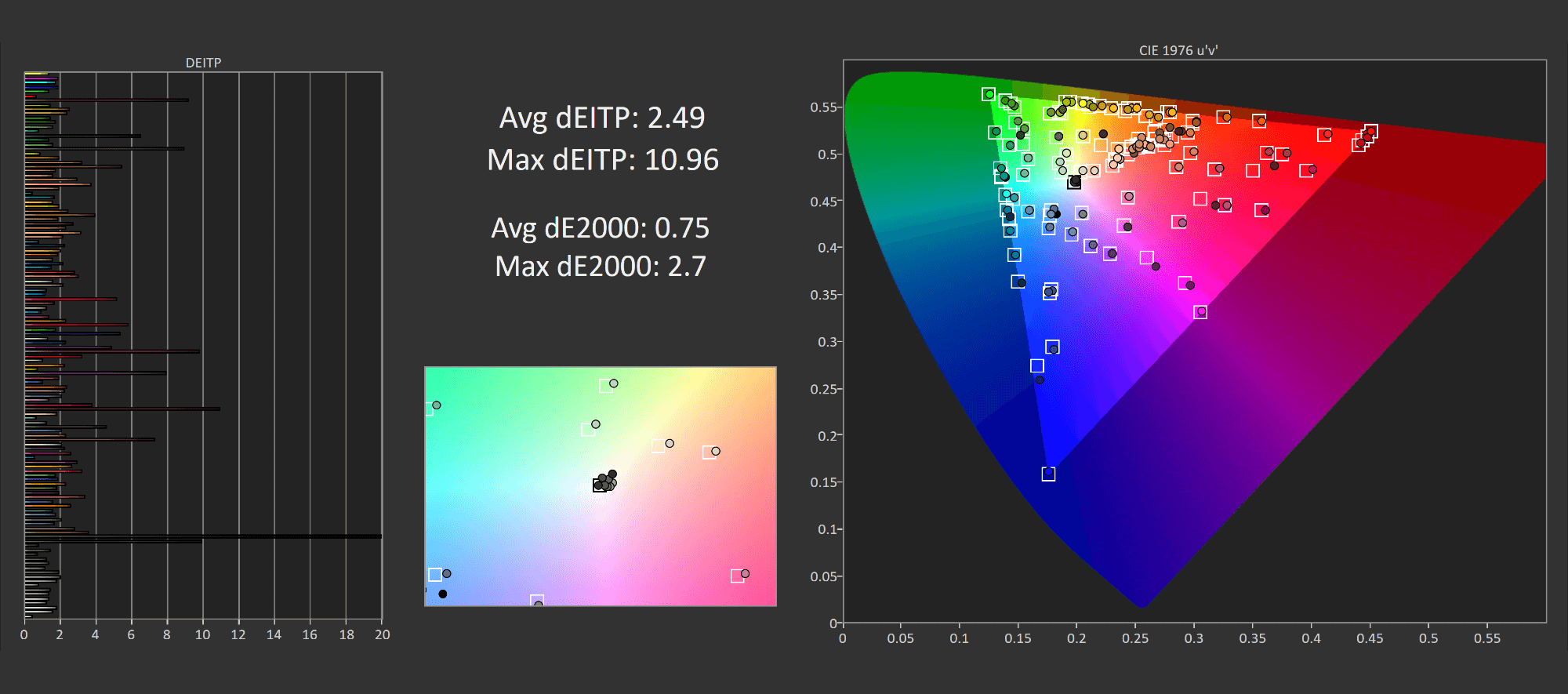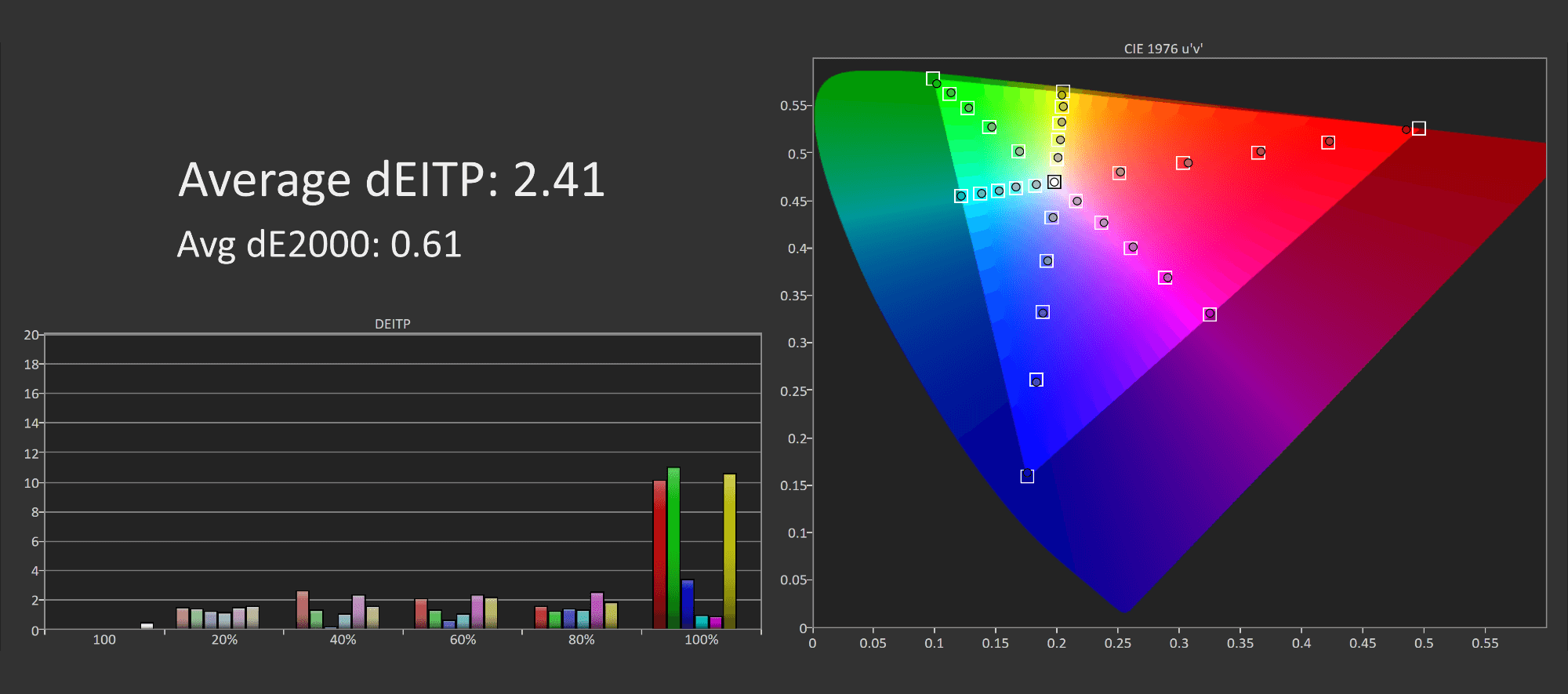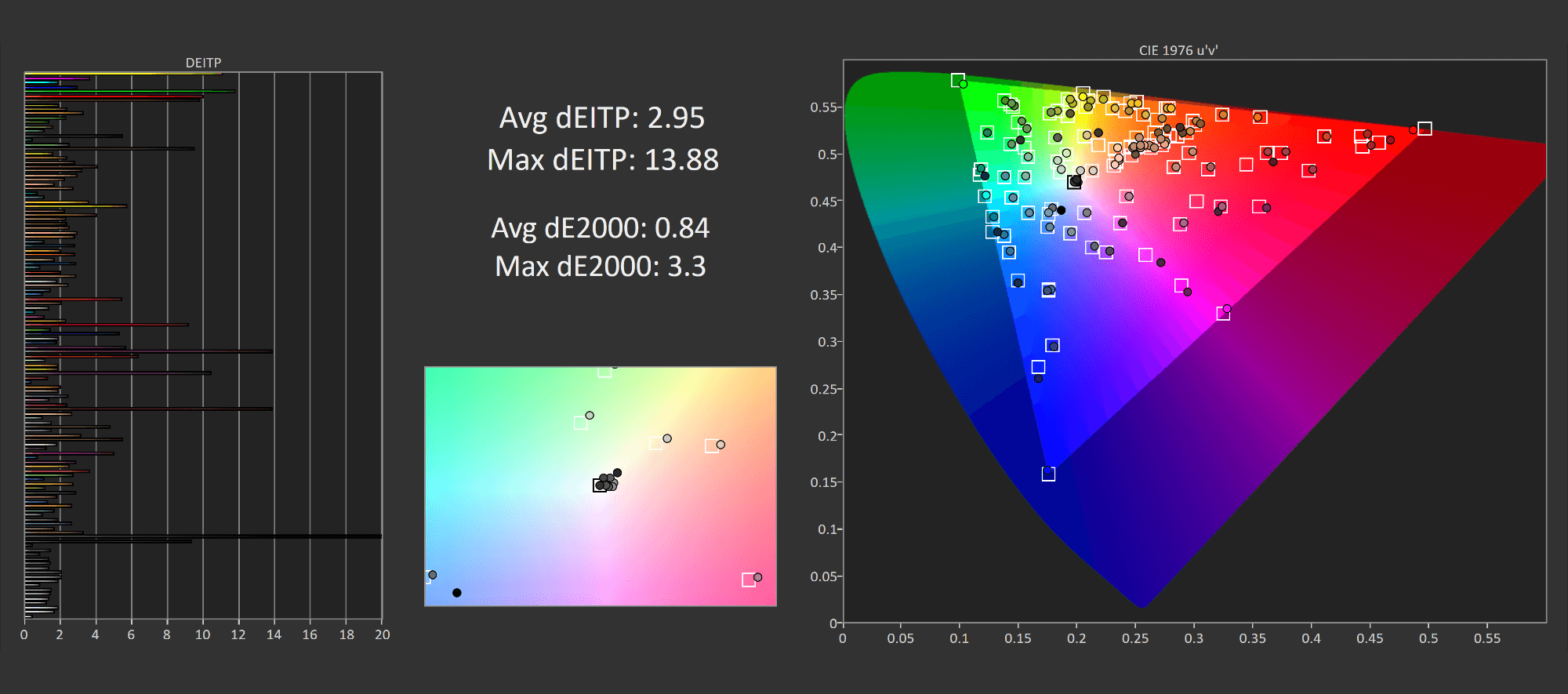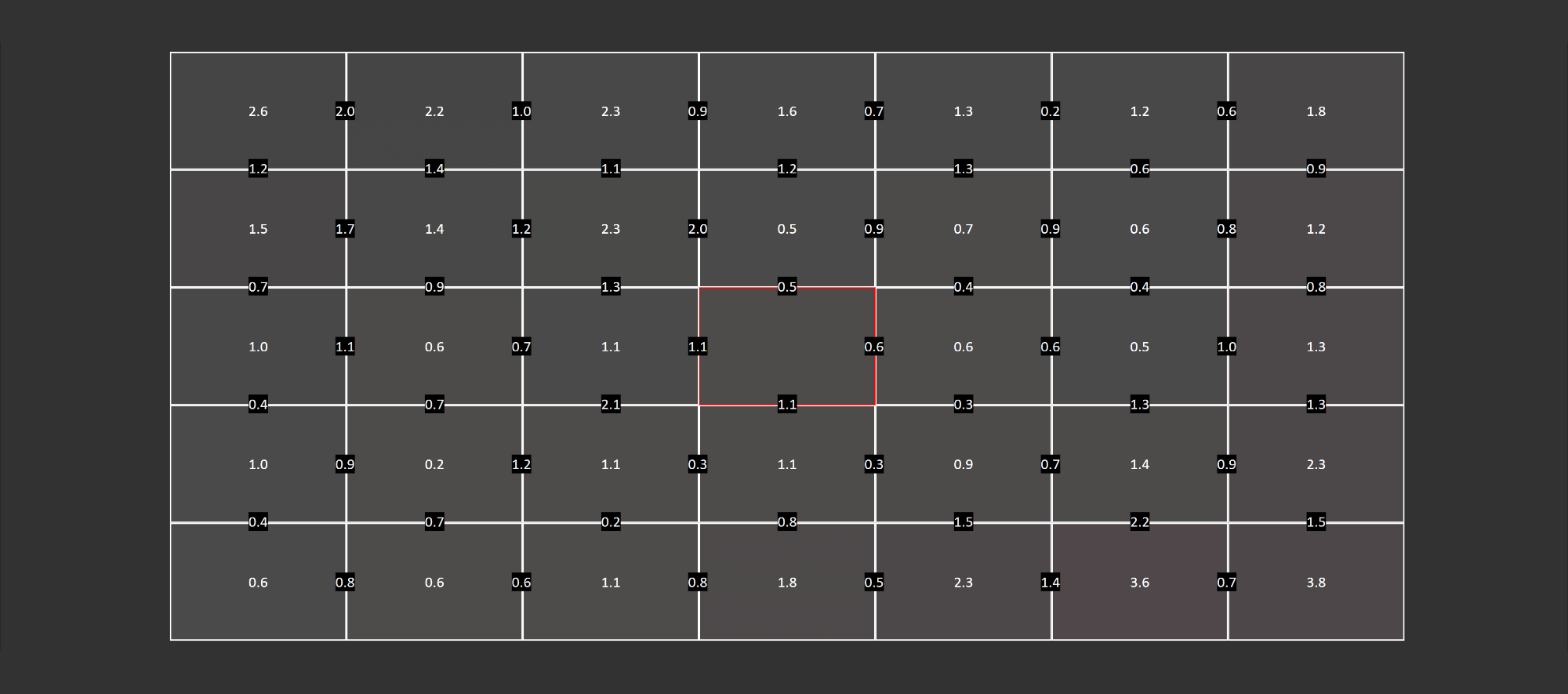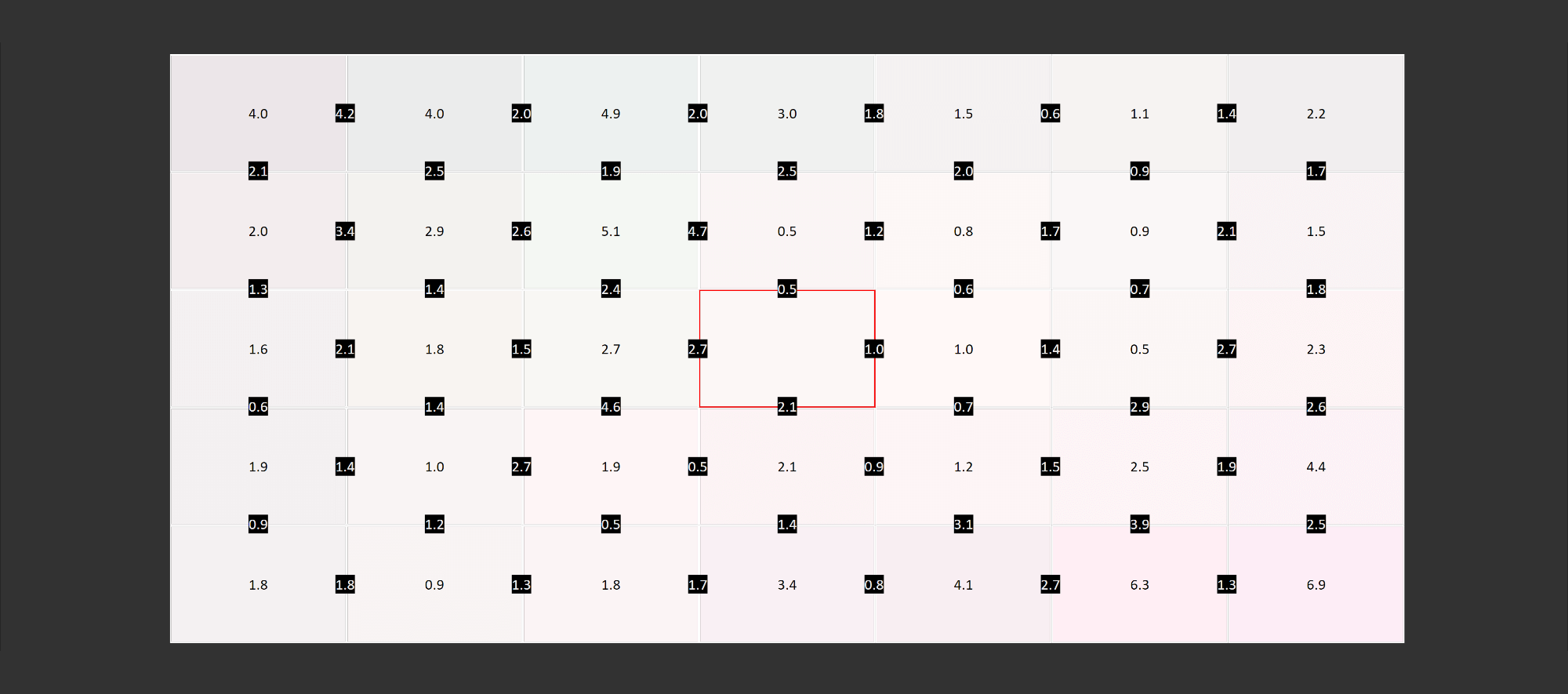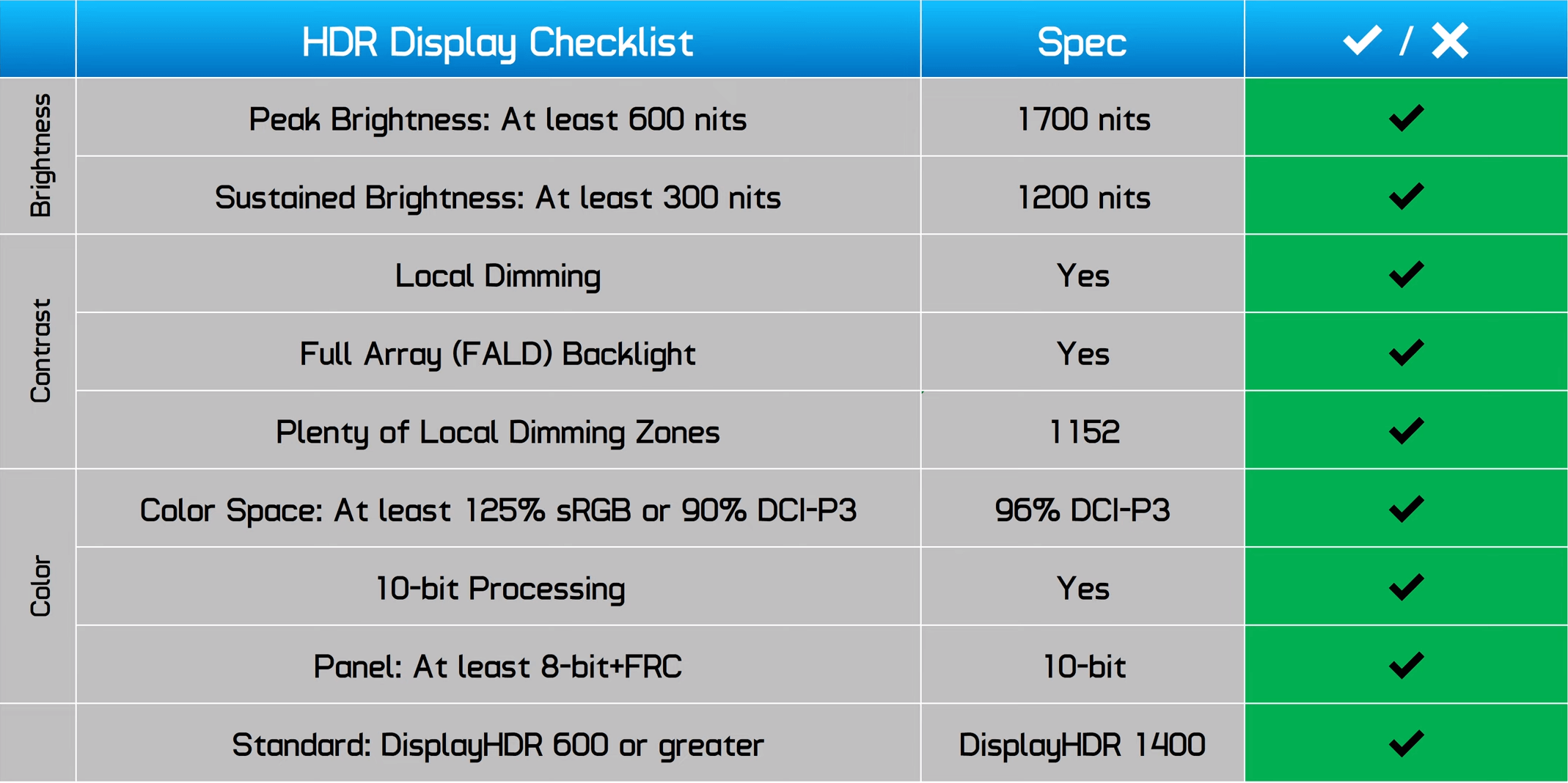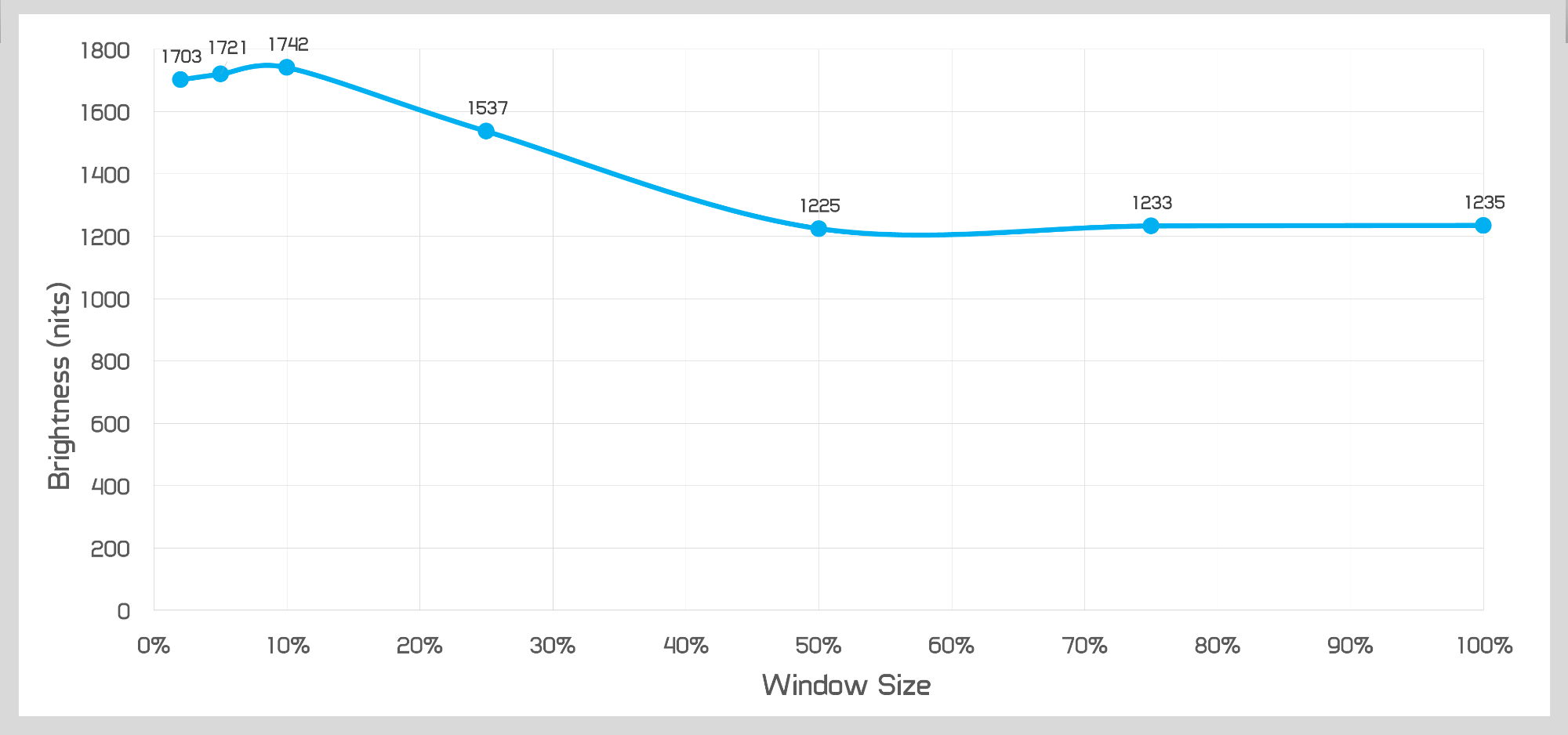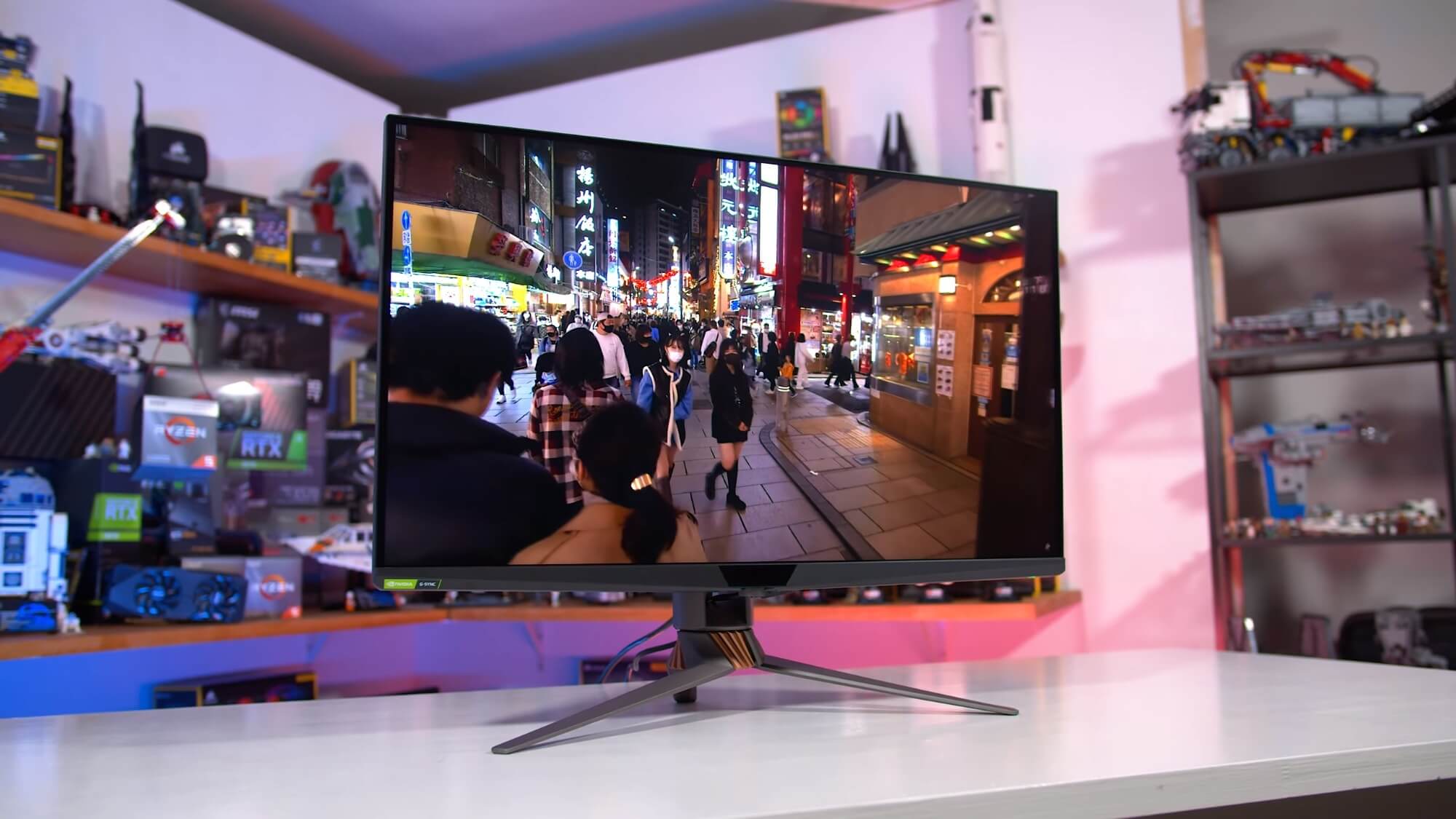The Asus ROG Swift PG32UQX is a latest generation, true HDR monitor that we've been waiting a long time to finally test and review. The PG32UQX is one of the first ever 32-inch 4K 144Hz monitors – bringing decent gaming specs to a larger screen size – and is one of the very few gaming monitors on the market with a mini-LED full array local dimming backlight, giving it proper HDR credentials.
This is one of those displays that is a true flagship, with Asus going all out in basically every area they could. It's a G-Sync Ultimate display that uses Nvidia's G-Sync processor, bringing with it features like variable overdrive, although as it's the latest generation of module it also works perfectly with AMD GPUs even with adaptive sync enabled. It uses a Quantum Dot enhanced LCD panel with 98% DCI-P3 gamut coverage. It's DisplayHDR 1400 certified, meaning peak brightness up to a whopping 1400 nits in the HDR mode, and features 1152 backlighting zones. And it uses an IPS panel with a nice flat screen.
On paper, there's no feature left out: large screen, high resolution, high refresh rate, top end HDR specs. Buyers should be hoping that a display like this will last multiple generations of PC hardware. And as the feature list is so comprehensive and high-end, so is the price tag: it has an MSRP of $3,000, although in Australia it's not as bad at $3,600 AUD, which is about $2,500 after adjusting for taxes.
Usually when it comes to reviewing a monitor, there's inevitably going to be some balance in the performance and price discussion. We don't expect affordable displays to have the best performance, it's all about bang for buck in those categories. But when you're forking out $3,000 for a high-end display, we do expect the best of the best, so that's the benchmark we are setting here.
The design Asus is using here is basically a rehash of prior ROG Swift designs, slightly modified to accompany the 32-inch 4K panel and mini-LED backlight. It's using the old style ROG stand that's elevated in the middle and includes their light projection feature, along with copper highlights. The build quality for the legs is nice, entirely metal, though the rest of the display is mostly plastic for the outer surfaces.
The rear continues to use what I would describe as Asus aggressive "gamer" design, which I've mentioned before that I'm not a huge fan of, though this is of course a matter of personal preference. There's a large ROG logo that's illuminated with RGB LED lighting, along with some patterns and different textures. This is not a subtle design and overall the monitor's housing is quite large.
The benefit to being a bit chunky is a very solid stand with little wobble and a decent range of ergonomics, including height, tilt and swivel support. I would have liked a larger range of height adjustability as I feel the maximum height is a little short for such a large display, and it's also missing any ability to use the display in a portrait orientation, although both of these things are solvable through a VESA mount which is supported.
There are a couple of unique inclusions as well. The LiveDash OLED screen in the center of the front bezel, consists of a 2-inch display that can be customized to show PC information such as temperatures and clock speeds, or images including animated GIFs. It's one of those neat little gimmicky features that companies like to add to high-end products.
On the top of the monitor, Asus also includes a USB port, which is a little odd to see at first. But the reasoning is that combined with the mounting hole, game streamers can neatly mount a camera on the top of the display. In addition to the top USB port, there's two more USB ports alongside the inputs.
Speaking of display inputs, there's good and bad news. The good is the DisplayPort connection supports Display Stream Compression (or DSC), meaning we get full 4K 144Hz RGB support without chroma subsampling. This was a big issue with the first wave of 4K 144Hz monitors but has since been resolved. The PG32UQX can do 8-bit+FRC at 4K 144Hz or native 10-bit at up to 4K 120Hz.
The bad news comes in the form of the HDMI ports. We do get three HDMI ports, however they are only HDMI 2.0, meaning they are capped to 60Hz using a 4K RGB output. This is a major disappointment on such a high-end display, if I'm paying $3,000 I really do expect the ports to be HDMI 2.1, or for at least one port to support HDMI 2.1, so it can utilize the full resolution at 144 Hz. We're not even talking about a brand new connector here, HDMI 2.1 has been utilized in TVs for several generations now, and of course is part of the new Xbox and PlayStation consoles as well as the latest GPUs.
So why glaring omission? That's because the G-Sync module doesn't support HDMI 2.1. Asus and Nvidia will tell you that using a G-Sync module is necessary to get adaptive sync and high refresh rates working in conjunction with the FALD backlight, quite a hard task and why HDR gaming monitors aren't as prevalent as many would like. However apparently this hard work stops short of including the latest HDMI specification, which in my opinion isn't good enough for such an expensive display.
The lack of HDMI 2.1 doesn't just limit future proofing, it's already limiting the display now as HDMI 2.1 capable devices are on the market. Console owners have to compromise the experience to 4K 120Hz using chroma subsampling over the HDMI 2.0 port, or stick to 60Hz, although variable refresh rates are supported on the Xbox Series X.
The on-screen display is controllable through an interesting dial arrangement on the bottom edge of the display, instead of the traditional directional toggle that we're used to on Asus displays. I don't mind the dial to be honest, I found it quite easy to navigate the menus and it's great for adjusting the sliders like brightness and color balance. You'll find most of the usual Asus features here: frame rate displays, crosshairs, low blue light modes, and lots of individual color controls. No backlight strobing though.
Display Performance
Now, for some response time testing, and it's a straightforward affair here, with the PG32UQX supporting three overdrive modes. The off mode is unimpressive, revealing poor native panel performance. A 23ms grey to grey response time average is not suitable for 144Hz gaming and while overshoot is low, the image is blurry. I don't expect many gamers to use this mode.
The normal mode is more acceptable. A response average of 8.77ms is fine though not as good as I've seen from an IPS panel, and with this particular display it's really split into two areas. The majority of transitions occur in around 5ms, which is pretty decent. However there are two sections of worse performance: any transition that ends in full white is slower than average; and many transitions that start in a bright value and end in a dark value are also very slow in this section here.
We also start to see some overshoot for close together transitions but this is not that visible in practice. The main noticeable artifact here are those slow fall times, which present as bright smearing in the UFO Test. We don't get a nice clean image in this mode unfortunately, and that's reflected by mediocre cumulative deviation numbers.
The Extreme mode at 144Hz isn't any better, in fact it's worse. Rather than solving the issue of slow fall times in some areas, the Extreme mode simply makes the majority of transitions even faster, leading to overshoot and noticeable inverse ghosting. I wouldn't recommend using this mode at the maximum refresh rate.
So the only usable mode is the Normal mode, which does hold similar performance across the refresh range thanks to variable overdrive. Rather than letting overshoot get out of hand at lower refresh rates, the PG32UQX reduces response time performance below 85Hz to keep the inverse ghosting rate below 30%, so overshoot artefacts aren't that noticeable while gaming. At lower refresh rates you can also see the issue of slow fall times reducing to the point where it's negligible at 60Hz. However the by-product of this is weak overall performance at 60Hz, you can see here an 11ms average response time.
As a result, the PG32UQX does have a single overdrive mode experience, we get 70% refresh rate compliance at 144Hz in the Normal mode, along with managed overshoot at 60Hz, so you can basically keep the overdrive setting on the default Normal mode and forget about it. However, unfortunately this mode overall isn't that amazing with some of the issues we talked about.

Compared to other displays, the PG32UQX's response time results are unimpressive. At its maximum refresh rate in the best overdrive mode, this display delivers a last generation experience, behind the best IPS monitors of today. You can see the PG32UQX is more in line with a 4K 144Hz display like the Nixeus NX-EDG274K than the current leader in the LG 27GN950: the LG model is 34% faster with lower overshoot as well.

Across all refresh rates tested, on average the PG32UQX also doesn't fair that well, again delivering performance similar to prior generation IPS panels, which are now used in more budget friendly models like the Nixeus, or Pixio PX277 Prime as a 1440p option. Performance is no better than the Acer Predator X27, the prior flagship G-Sync Ultimate 4K 144Hz monitor that was released in 2018, and well behind the LG 27GN950.

What really illustrates this issue are the cumulative deviation results, which measure how close the monitor's response time gets to the ideal instant response, and quantifies the balance between overshoot and response times nicely. The PG32UQX is clearly a step behind current generation IPS panels, which deliver cumulative deviation in the 500 to 600 range, roughly 50% better than what the PG32UQX is capable of. It's actually worse than the Predator X27 in our testing, a monitor we re-tested just a few weeks ago, which is a remarkably bad result for a high-end product.
This is all down to those slow fall times really, the artifacts that issue creates are visible and prevent the PG32UQX from matching today's best IPS monitors. And this metric is such a great way to quantify that: the PG32UQX has artifacts in motion that the other monitors do not have.

Dark level performance isn't that much of an issue, so despite some slow fall times, you won't see much dark level smearing, certainly nowhere near the level of the worst VA panels.

At a fixed 120Hz, the PG32UQX again is a step behind the best monitors on the market today. It doesn't have anywhere near the level of overshoot as the Acer Predator X27 which is an improvement, however response times are still noticeably slower than the 27GN950 and more in line with mid-range or entry-level displays.

At 60Hz, while overshoot is low thanks to variable overdrive, the reduction in response performance hurts this display and makes it one of the weakest monitors we've tested and well behind the 27GN950.


Input latency is acceptable given the response time results, with next to no processing delay. The only elements holding this display back are the 144Hz refresh rate - 240Hz monitors will naturally have better input lag - as well as the slower response times. As for power consumption, being a G-Sync product with a FALD backlight, power consumption is higher than most other monitors which use more simple backlight constructions that tend to be more efficient.
Color Performance
Color Space: Asus ROG Swift PG32UQX - D65-P3
While motion performance may be disappointing, color performance in general is not. The PG32UQX has a very wide color gamut, encompassing 96% of the DCI-P3 color space in our testing, along with 100% Adobe RGB coverage. This makes the monitor great for productivity work in both print and video which requires one or the other of those wide gamuts. Total Rec. 2020 coverage ends up at 82% which is as good as other current AU Optronics high end IPS panels like we saw in the PG329Q.
Despite having such a wide color gamut, Asus have properly calibrated this display at the factory and ship it with an sRGB clamp (or sRGB emulation mode) enabled by default. This means you won't see any oversaturation while viewing standard content like web pages, movies or YouTube videos in the SDR mode right out of the box. This is exactly how monitor manufacturers should be utilizing wide gamut panels, as most of today's content is still made for regular sRGB or Rec.709 displays: it should be sRGB by default, with the option to enable a wide gamut mode, and that's exactly what Asus has done so kudos to them.
In terms of accuracy numbers, in our saturation sweeps we see a deltaE 2000 average result below 2.0 and deITP around 4 which is very good, and this carries across into the ColorChecker results, indicating only a small difference between what the monitor outputs and what is accurate. Greyscale results are not as good, there was a slight tint with my unit but reasonable adherence to the sRGB gamma curve.


What this means is that compared to other monitors, the PG32UQX has noticeably better factory ColorChecker accuracy. The majority of displays here are wide gamut, and almost none of them limit that gamut to sRGB from the factory. The PG32UQX does, making it miles better than its competitors. Greyscale accuracy though is more mid table, not a bad result by any means but it could be a bit tighter from the factory.
OSD Tweaked Performance
Luckily though, despite shipping with the sRGB mode enabled by default, there are no limits in this mode whatsoever. So you can happily go about adjusting the brightness and color balance to deliver a more accurate result. And that's what I did, I was able to achieve a sub-2.0 deltaE average in all three of our tests without using an ICC profile, an outstanding result and exactly what I like to see from premium monitors.
Calibrated Color Performance
When fully calibrating the display using DisplayCAL I was able to improve performance again to a small degree. The main reason you'd want to go through this process on the PG32UQX isn't necessarily for sRGB content, but for wide gamut content. The gamut is so wide that neither P3 nor Adobe RGB will be accurate out of the box, but the use of an ICC profile does improve that substantially in properly color managed apps. You can see my results of P3 calibration right here and it's very good, I'd expect it to be even better for Adobe RGB so if you're thinking of buying this display for gaming and content creation I think it would be a good choice.

Brightness in the SDR mode tops out at just over 500 nits in my testing, which is much higher than most people will find necessary but high enough that all use cases should be covered. Minimum brightness is also great too at just 40 nits, so if you're viewing web pages in the dark you can turn the display right down to reduce eye strain.

Here is a look at the IPS panel's native contrast ratio with local dimming disabled. We're actually getting a really good result here of 1300:1, very decent for an IPS although still well behind VA panels. We will talk about contrast with local dimming enabled soon, but this number is still important because for creative or productivity work I'd probably recommend disabling the variable backlight just to prevent any small amounts of bloom or haloing. With a good result here, you can disable the variable backlight without having to revert to a terrible contrast ratio, although I should note that even in the default SDR mode the variable backlight is enabled by default. There's no substantial change to accuracy between having the backlight on or off.
The PG32UQX we reviewed had okay display uniformity, but nothing amazing. One of the major issues with a full array backlight is there are so many LEDs individually illuminating part of the display, compared to just a few in most traditional edge lit LCD designs. This means that for great uniformity, you need all of these 1000+ LEDs to output the exact same color, which is a non-trivial issue as not every LED is exactly the same, there's always some manufacturing tolerance.
So what my monitor ended up being was reasonably uniform for the most part, but with a few areas that had a noticeably different color tone. In the upper middle-left area I measured a slightly blue tint relative to the center, and in the bottom right there was a slightly red tint. This isn't noticeable when viewing content or playing games, but if you're just looking at a perfectly uniform image - like the background of a webpage or a blank document - you may spot this. At the end of the day this is just the reality of current FALD monitors which are more designed for content consumption than perfect studio grade uniformity.
Testing HDR
The final part of this review is, of course, about the HDR functionality. A quick look at the HDR checklist reveals the monitor is indeed true HDR. It has a high peak brightness in excess of 1000 nits, a large amount of local dimming zones to achieve a high contrast level, and a wide color gamut with 10-bit support. On paper, everything is here for displaying HDR content as intended.
The one thing that was immediately apparent from using this display is that the 1152 zone full array local dimming backlight is significantly better than previous 384-zone panels like the Acer X27. Having three times the number of backlight zones noticeably reduces blooming and haloing in the most challenging HDR situations, such as tiny bright objects surrounded by darkness. On the X27, the halos were noticeable and significant, and depending on the content could hurt the experience. With the PG32UQX, haloing is a lot smaller and less noticeable, to the point where in the majority of real world content I couldn't really notice it.
That's not to say the backlight is perfect though. Punishing HDR scenes, like star fields or intricately detailed lights, do still lead to a small amount of blooming at times. This isn't an OLED, which is really the only type of consumer panel that can handle that sort of content. I also found that the backlight could struggle a bit with defined edges, particularly in desktop applications: if an edge is half way between two backlight zones you won't get a defined bright and defined dark area, and the mouse could cause a minor amount of haloing as well in some situations. But again, these issues don't really crop up in games or when watching HDR videos, this is significantly better than previous FALD monitors and in my opinion delivers a great HDR gaming experience.

The PG32UQX in my testing is extremely bright, the brightest monitor I've tested so far. It can sustain over 1200 nits when displaying a full white window, which is punishing on your eyes from a close distance. That increased to nearly 1800 nits in a full screen flash, well above other monitors and exceeding the display's own 1400 nit rating. Bright flashes from explosions are mighty impressive with this level of brightness.

The PG32UQX is also able to sustain a much higher brightness for small areas than other monitors, pushing up to 1742 nits when viewing a 10% window, again higher than every other display. At no point did I measure a sustained brightness level below 1200 nits, for most content I'd say peaks of 1500 nits or above are achievable which is fantastic for HDR.

As for contrast, when viewing full screen sustained contrast the PG32UQX reached the limits of my tools, as the backlight is able to dim itself down to a very low level. It doesn't fully switch off, but gets so low that my tools can't measure it, leading to a dynamic contrast ratio of at least 100,000:1 and likely north of 400,000:1.

But for HDR viewing we are more concerned about the contrast visible within a single frame, so we can see bright and dark areas on the screen at the same time. In the best cases where a bright and dark area are separated, the PG32UQX again delivers outstanding numbers. The FALD backlight is extremely effective in this situations, much more effective than with the Predator X27 which wasn't able to dim its screen to as significant of a degree. It also easily beats most DisplayHDR 600 monitors, like the Alienware AW2721D which have insufficient levels of edge lit local dimming. The PG32UQX is likely at least 10 times better than an edge lit display with contrast of 20,000:1 or lower in this test.

Our almost worst case test for HDR has a bright and dark area close together, which measures a display's ability to effectively dim dark areas. Edge lit dimmed displays are woeful in this test, quickly falling to or below their native contrast ratio, highlighting that in some situations edge lit panels have no functional dimming at all. Meanwhile the PG32UQX is the best monitor we've tested in this metric, delivering approximately 4x its native contrast ratio through local dimming. A contrast ratio of 5000:1 isn't mind boggling but does deliver great results in most true HDR scenes.

Lastly I've got an HDR checkerboard test for contrast which is basically as bad as it gets. Some monitors perform terribly in this test, especially for the low brightness checkerboard as the backlight simply cannot get dark enough to provide an effective level of contrast. Again, displays without full array local dimming perform so badly they are basically not HDR monitors at all, and depending on how they handle HDR at times they can look worse than SDR.
However the PG32UQX flexes its muscles here with only a slight reduction in contrast compared to the previous graph. The 1152 zone backlight is also clearly more effective than prior 384 zone designs, and I think this chart nicely illustrates the differences in haloing. The Acer X27 has contrast no better than native even with the FALD backlight enabled, while the tighter ability to darken the screen with the PG32UQX's backlight sees it deliver over 4x better contrast.
What We Learned
The Asus ROG Swift PG32UQX is one of those monitors that's pretty hard to come to a conclusion on, because results are mixed, so depending on your preferences you might think this display is anywhere from awesome to terrible. I personally sit somewhere in the middle, which is ultimately disappointing for such an expensive product.
There are plenty of positives. The HDR experience is the best that I've seen from a consumer gaming monitor yet. It's a noticeable improvement over the prior generation of displays that didn't use mini-LED backlights. The PG32UQX gets very bright and has great local dimming, leading to a true HDR experience that can show dazzling lights and dark shadows on screen at the same time. The only way you get better HDR at this size is to grab a professional grade OLED, but then you not only have to pay more money, you also have to sacrifice the 144Hz refresh rate for 60Hz. So in this class, the PG32UQX really does deliver the best HDR for gamers.
Asus has also nailed most aspects to the overall color quality. The panel produces a wide gamut with great coverage of both DCI-P3 and Adobe RGB. It has an excellent sRGB mode that's enabled out of the box for perfect viewing of regular SDR content without any oversaturation concerns. Factory calibration is generally above average, too, plus the panel's native contrast ratio is decent, and the brightness range is fantastic. It's really hard to complain about how this panel looks when displaying either SDR or HDR images, it's top notch.
But all of this has been let down by poor motion clarity and response time performance. This panel is simply a generation behind the latest IPS displays in overall speed, leading to some motion artifacts that today's fastest panels don't have. The performance we are getting is similar to what was around back in 2018 when the first wave of G-Sync Ultimate displays hit the market, but it's now 2021 and we've moved on to better and faster panels, including the LG 27GN950 at 4K, and even Asus' own PG279QM at 1440p. The PG32UQX feels a little stuck in the past in this area.
I suspect that a part of this can be attributed to the display's long development cycle. Asus announced this display back in early 2020, and was likely being worked on for years before that in partnership with Nvidia and AU Optronics. The length of time it took for it to hit the market has unfortunately seen this area of performance superseded.
I also feel the lack of HDMI 2.1 is a massive flaw. When you buy this sort of monitor, you want it to last a very long time and to support hardware not just from today, but from the next few years. HDMI 2.1 isn't some future proofing spec anymore, it's a requirement for some devices today to get the best out of this display's capabilities. I expect the best hardware, the best features and the best support in this price category and Asus aren't providing that when they can't include HDMI 2.1.
This leaves the PG32UQX in a difficult position. It's the best monitor we have for HDR gaming today, but it still feels compromised in a way that's not acceptable when the price tag sits at $3,000. So I find it hard to recommend on that basis, but then what else do you recommend for gamers with deep pockets that want that sweet HDR goodness? I guess this is indicative of the poor state of the modern HDR monitor landscape, I was really hoping to see more progress by now.
The only real alternative right now is to grab a fully HDR capable TV, which for many is not viable given their size. But something like the LG C1 OLED, which we'll be testing shortly, seems to me to be a far more compelling option at just half the price - if you can manage the 48-inch size! We'll explore that in detail soon to see whether it's worth considering.
